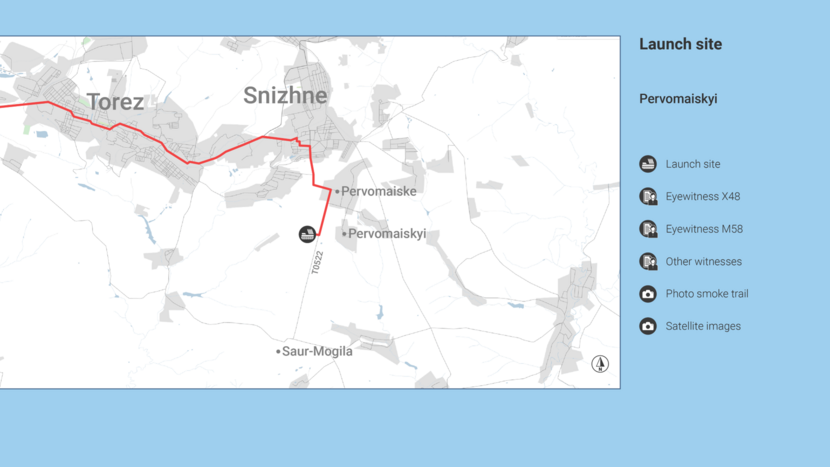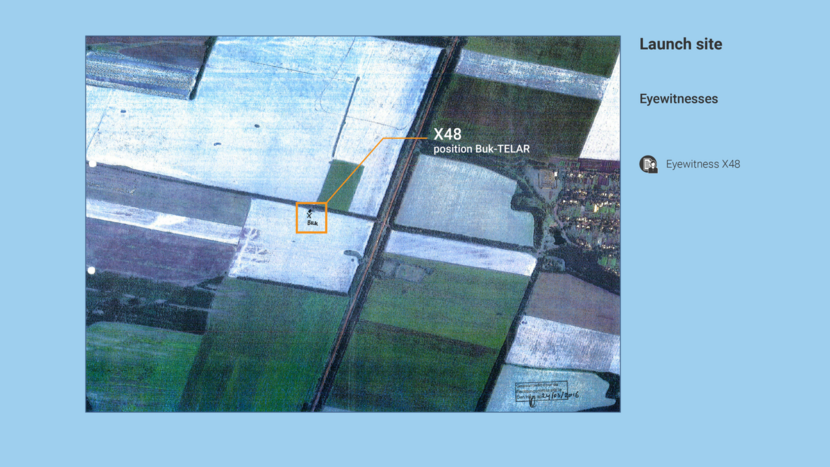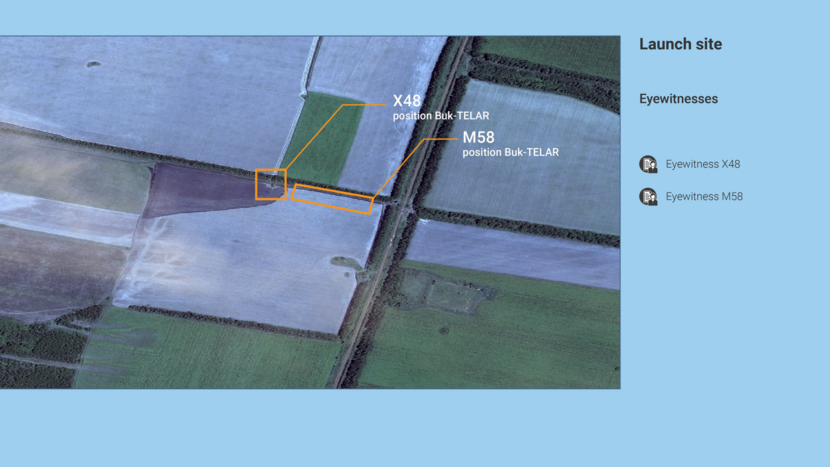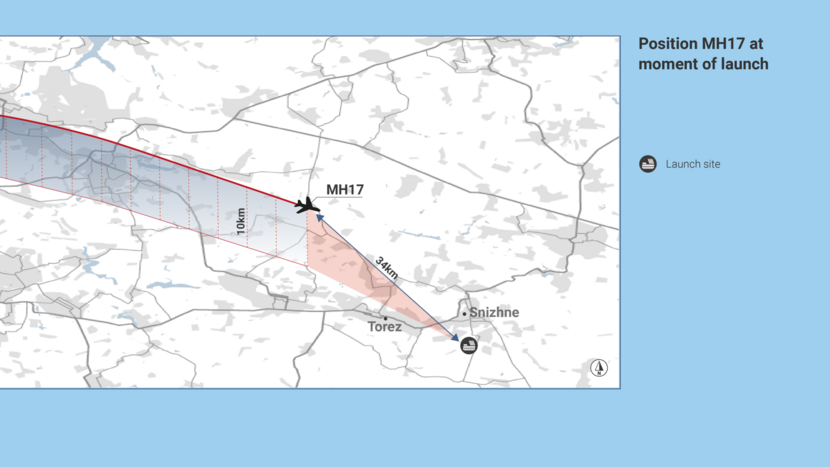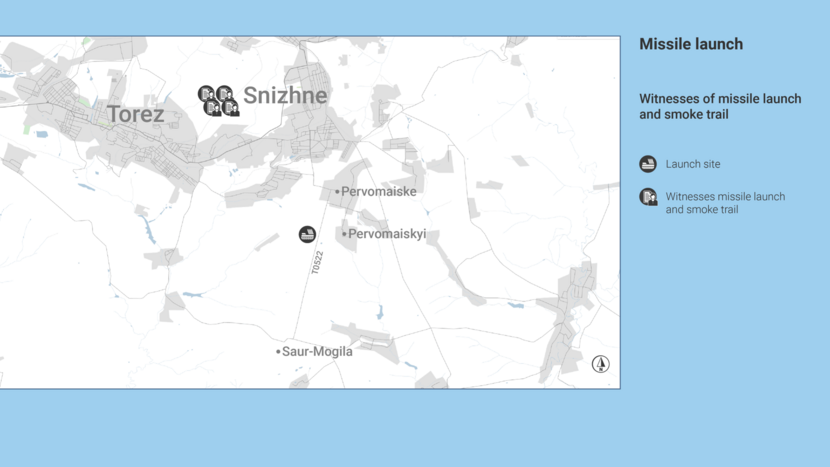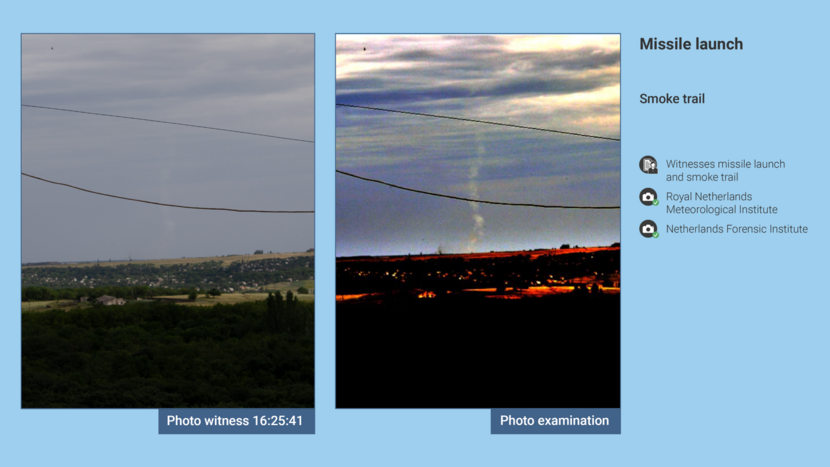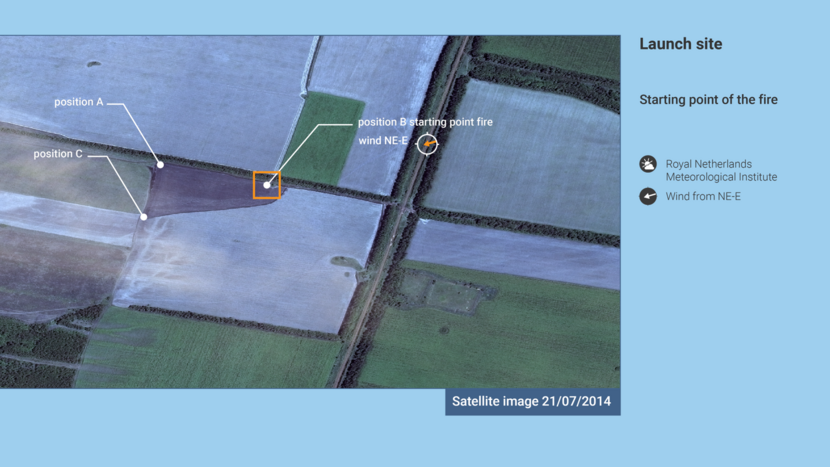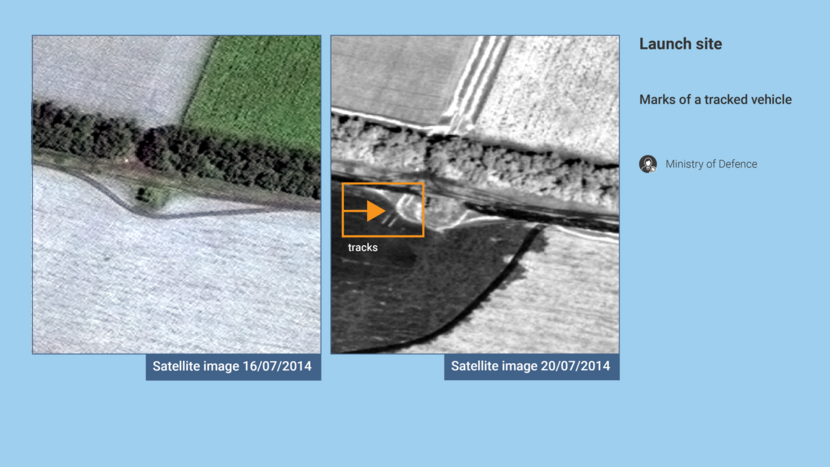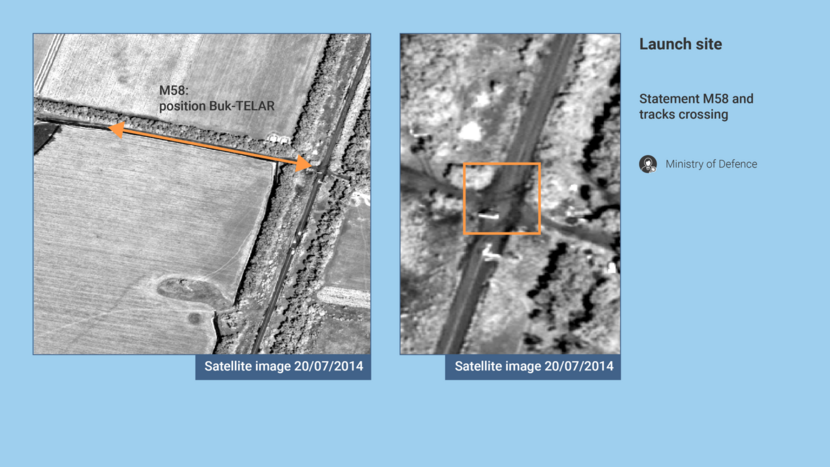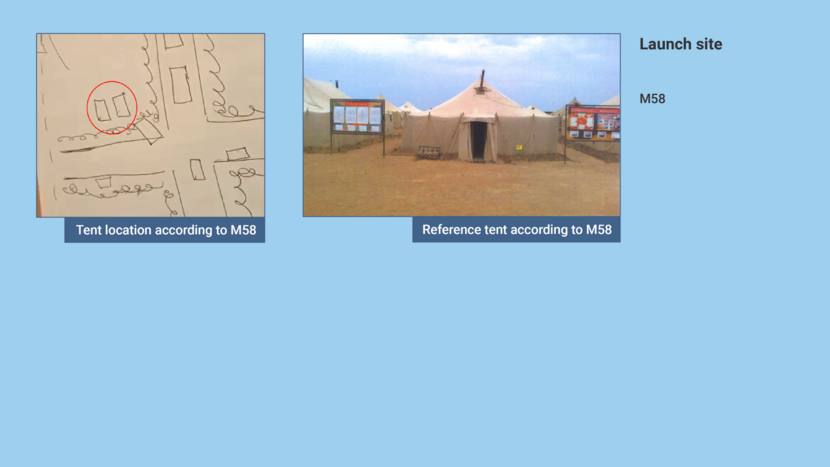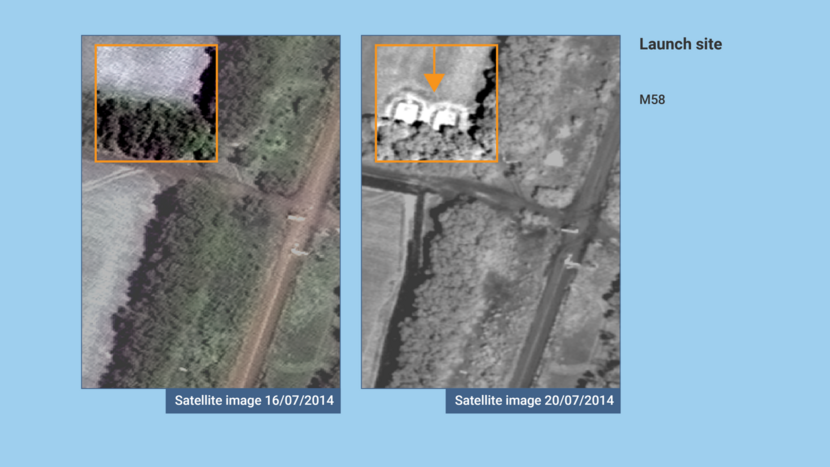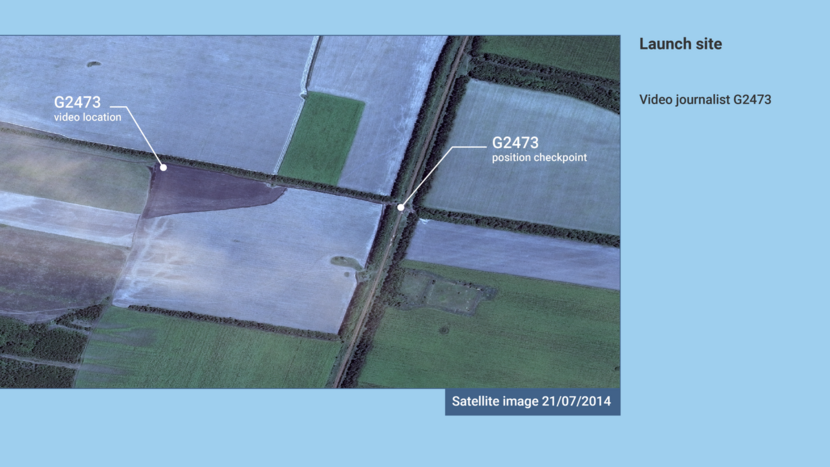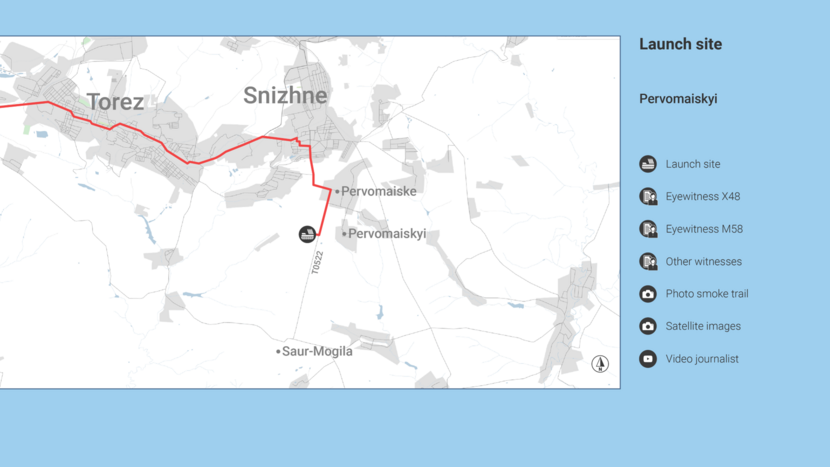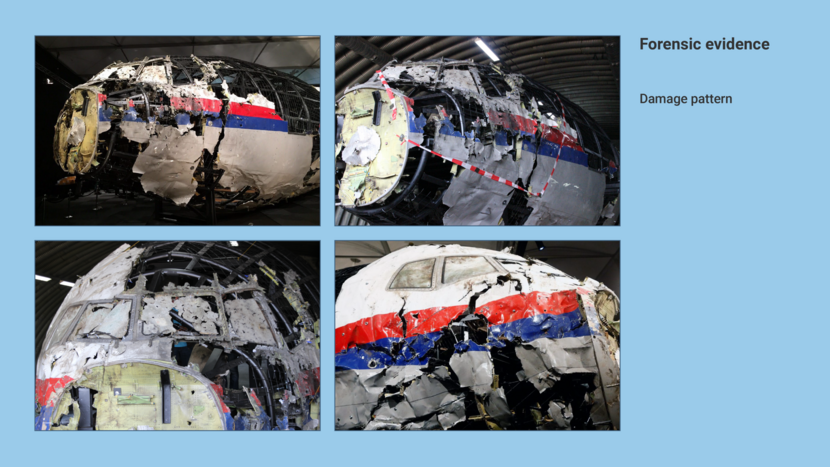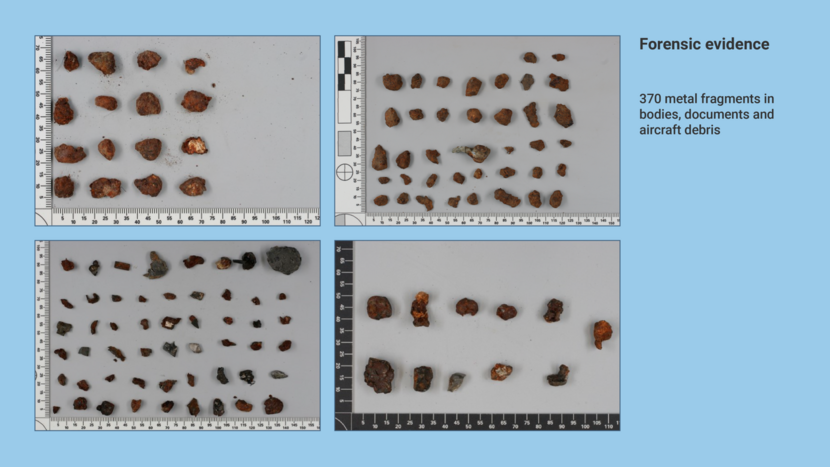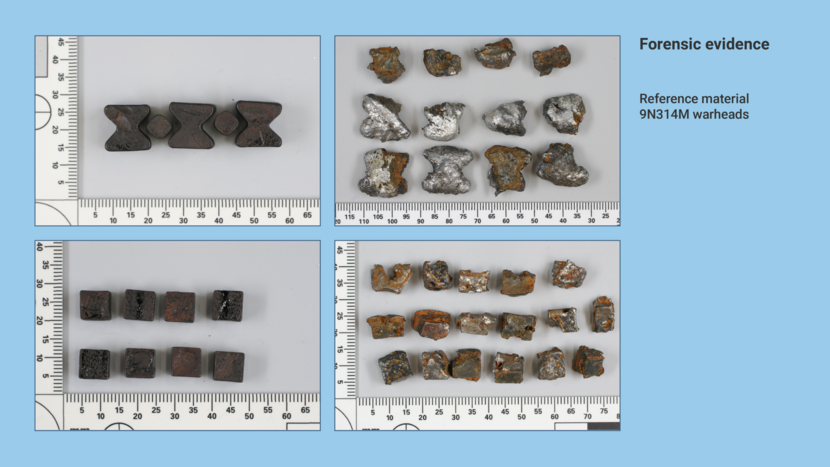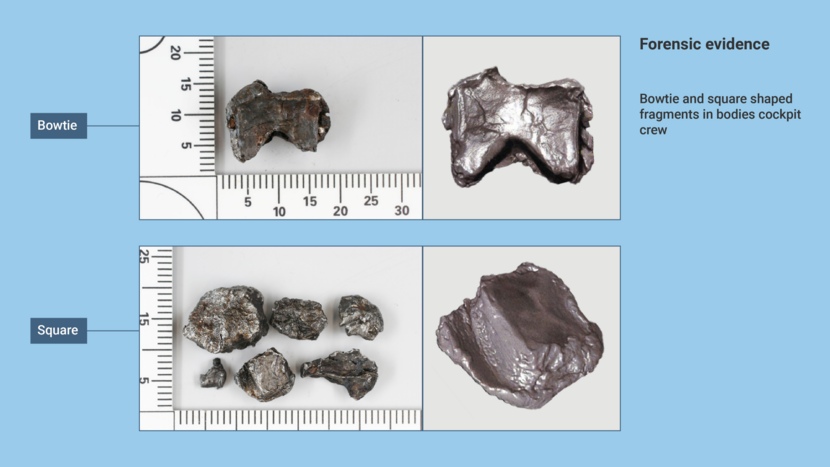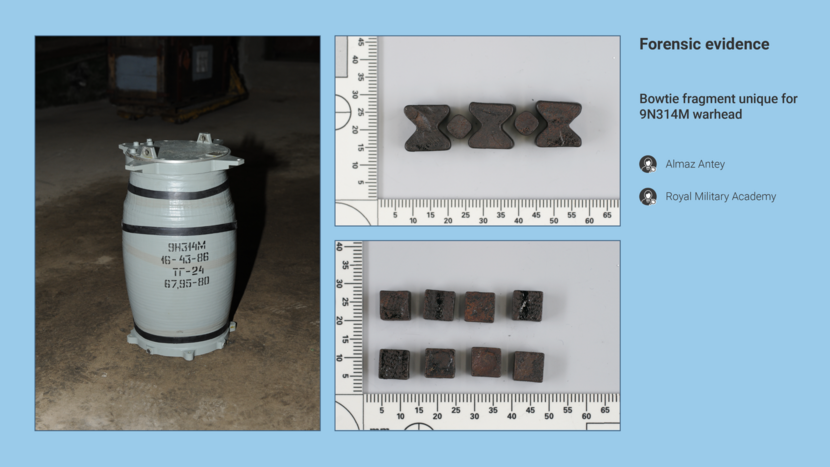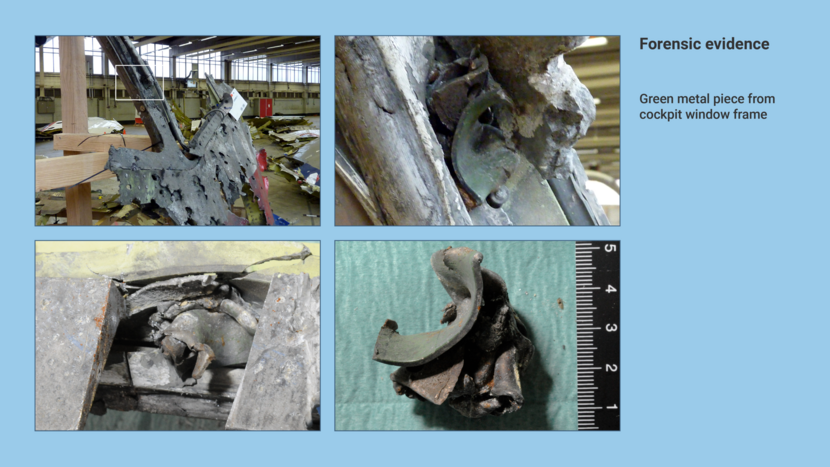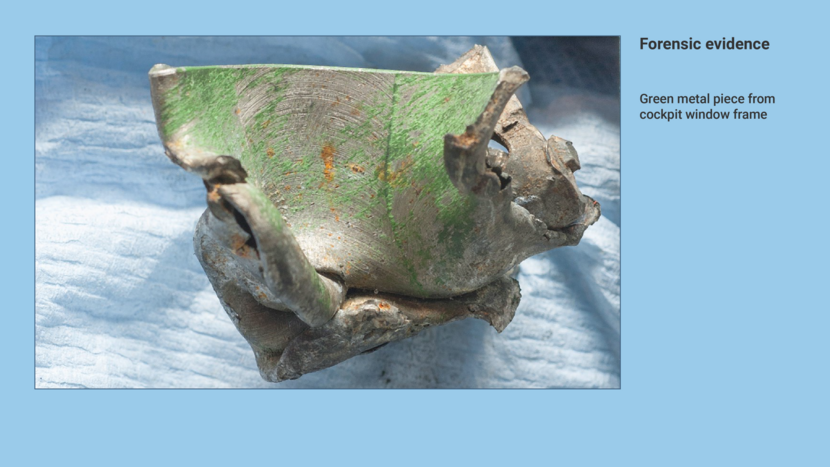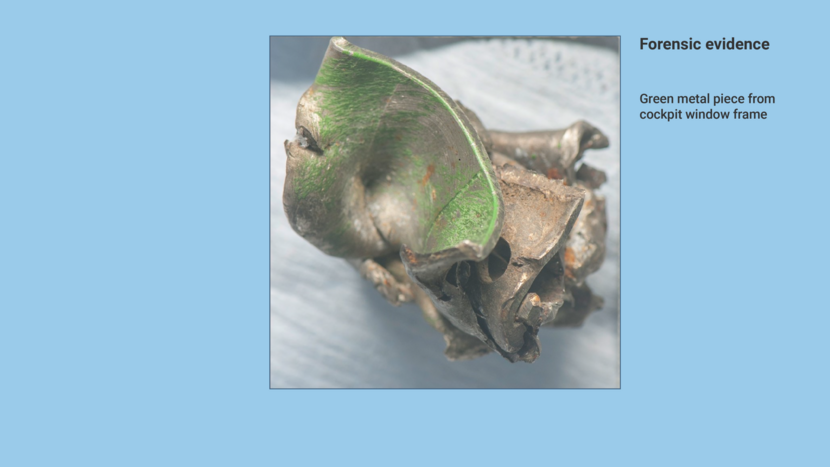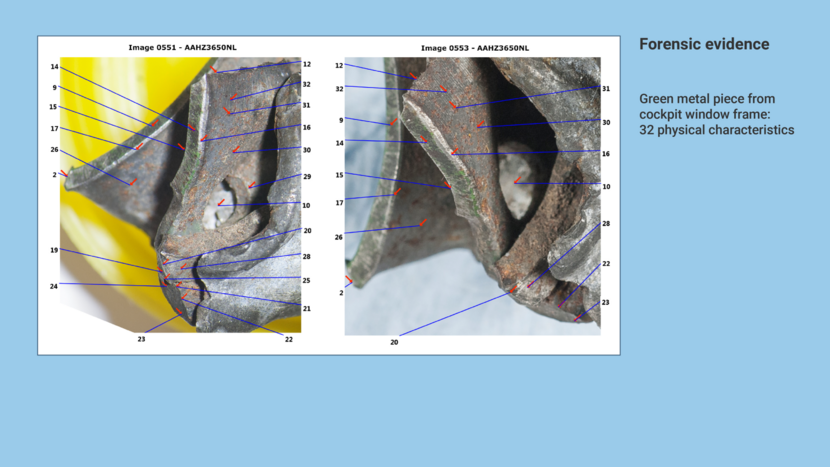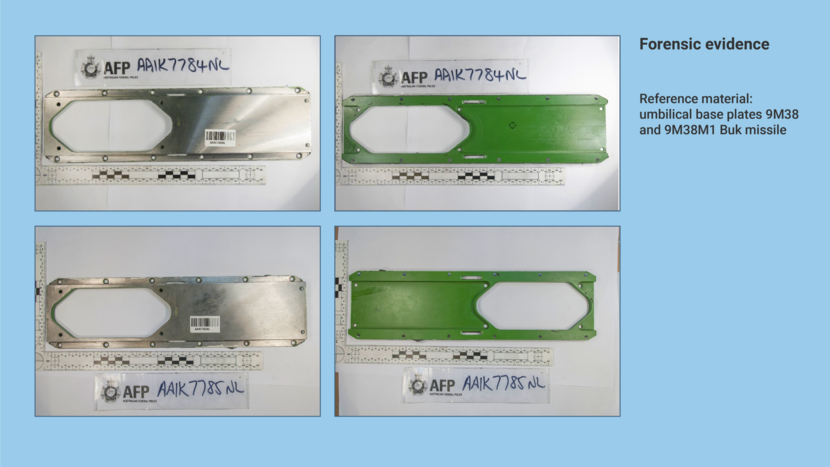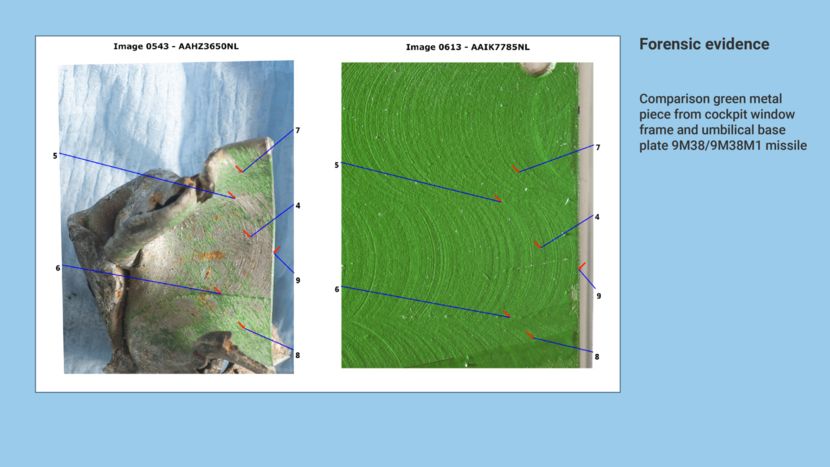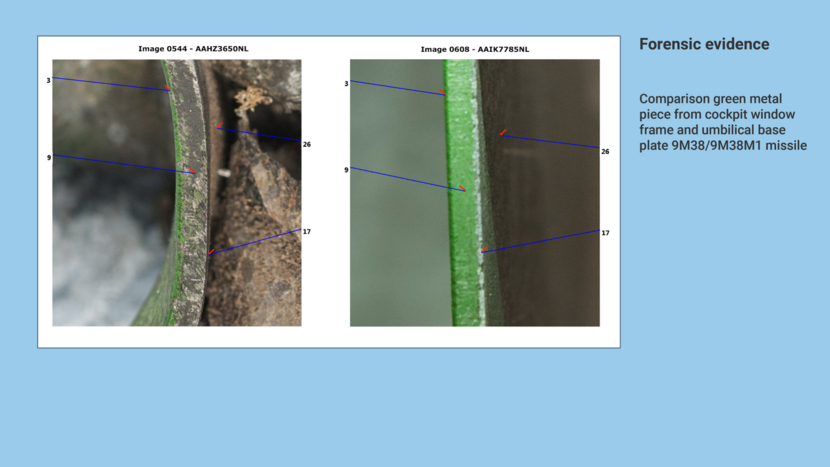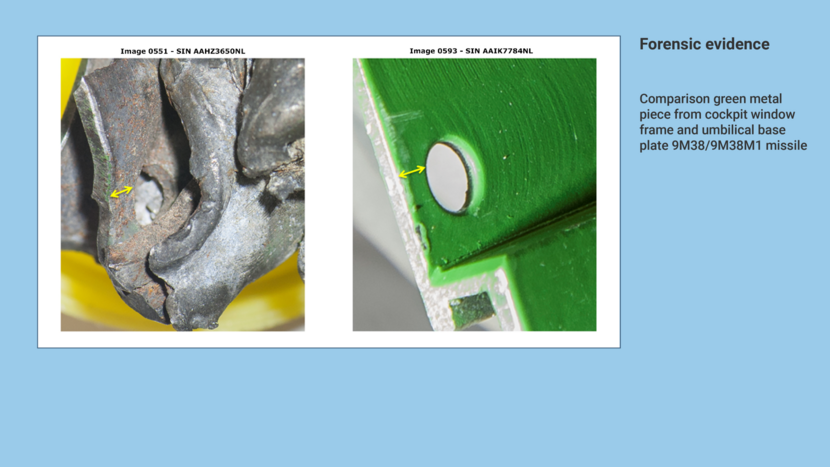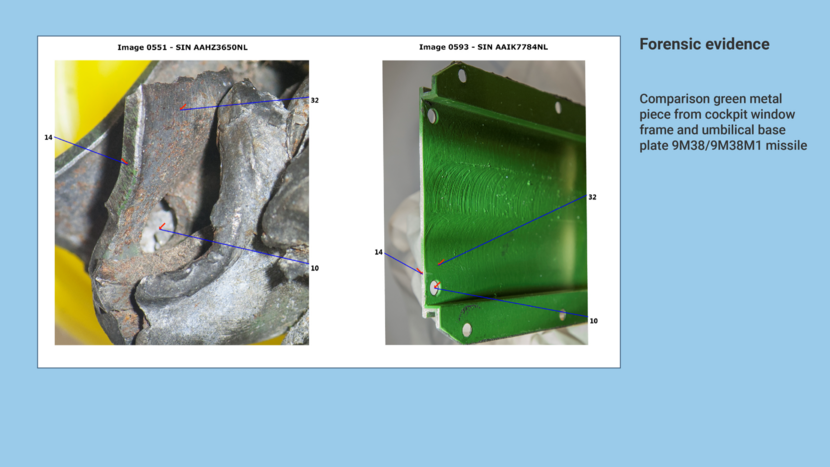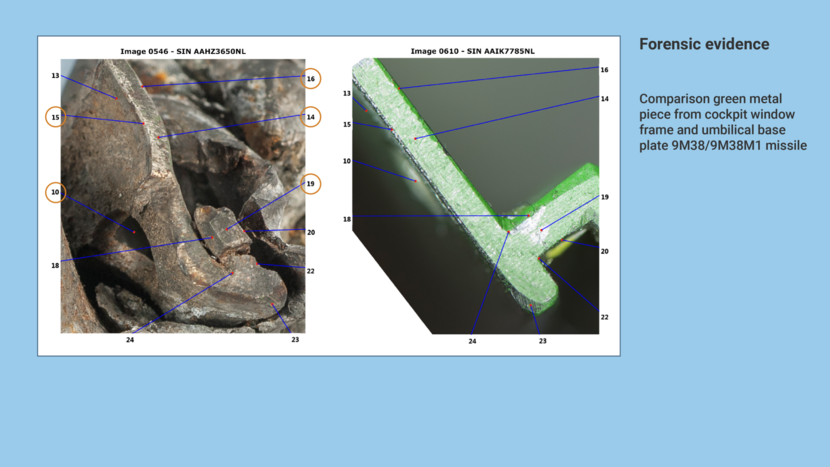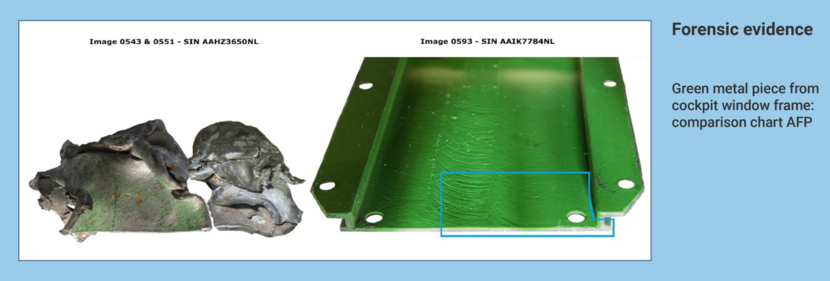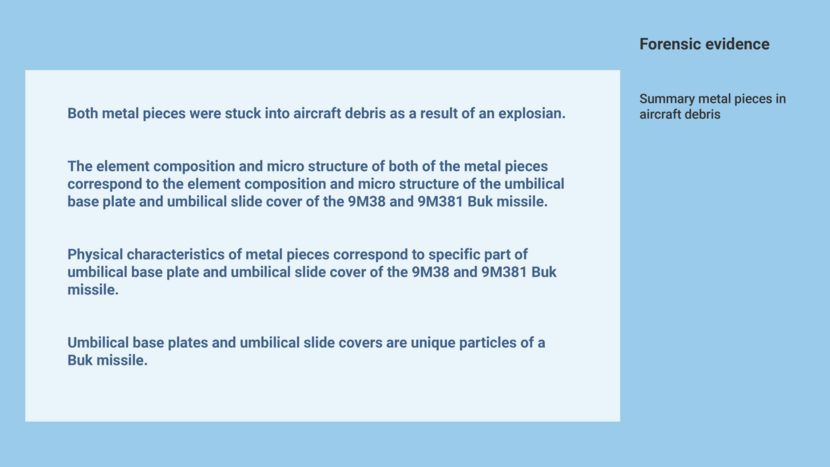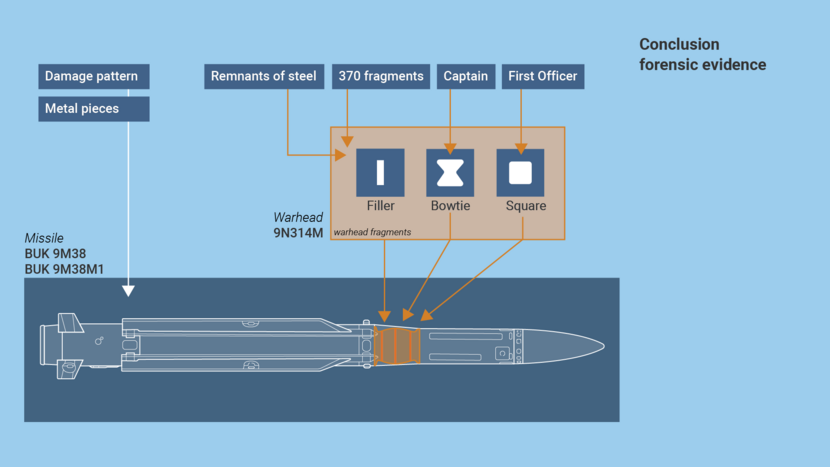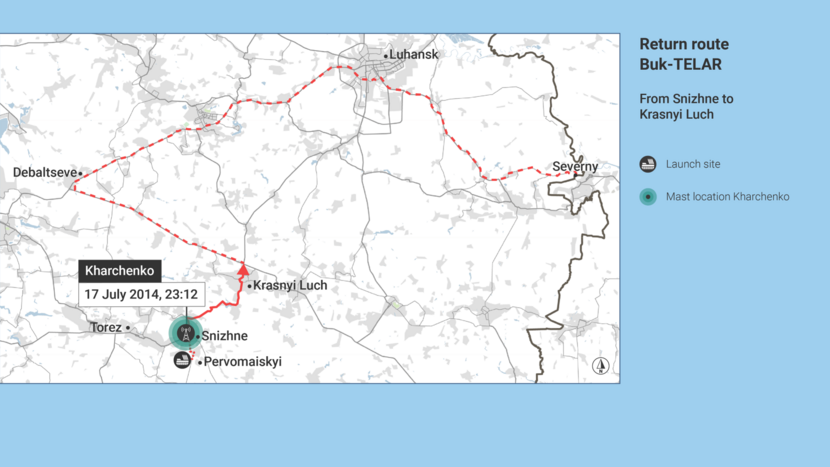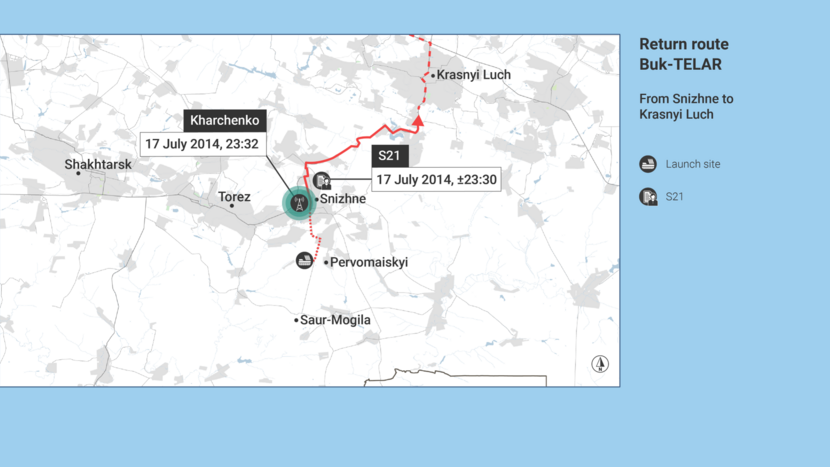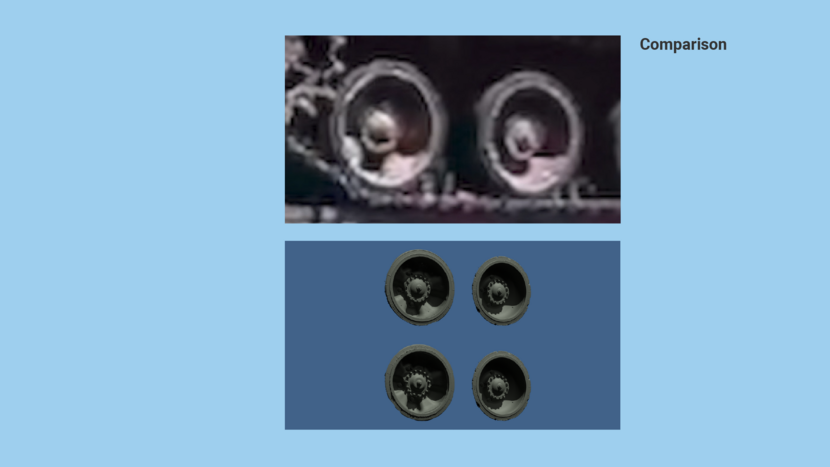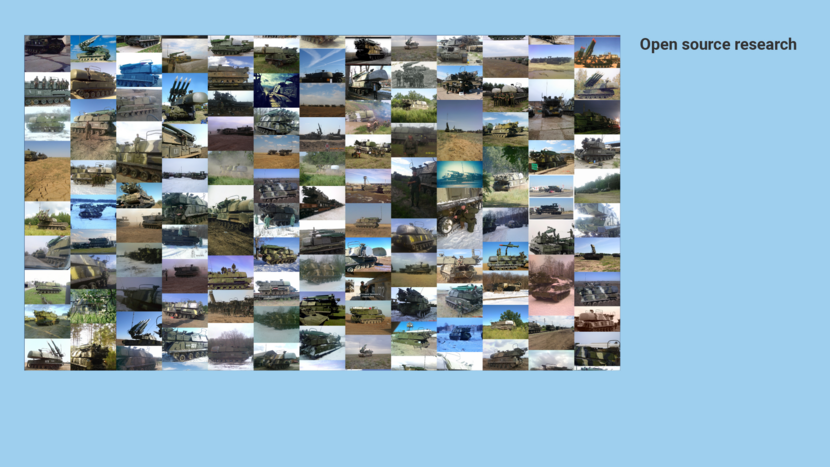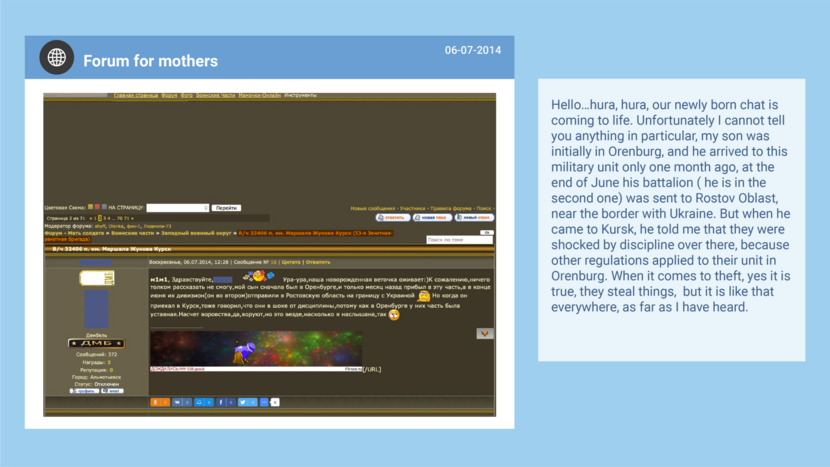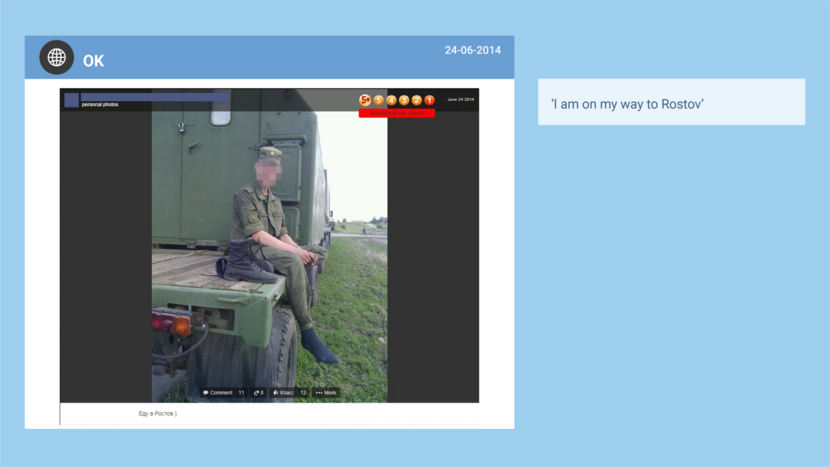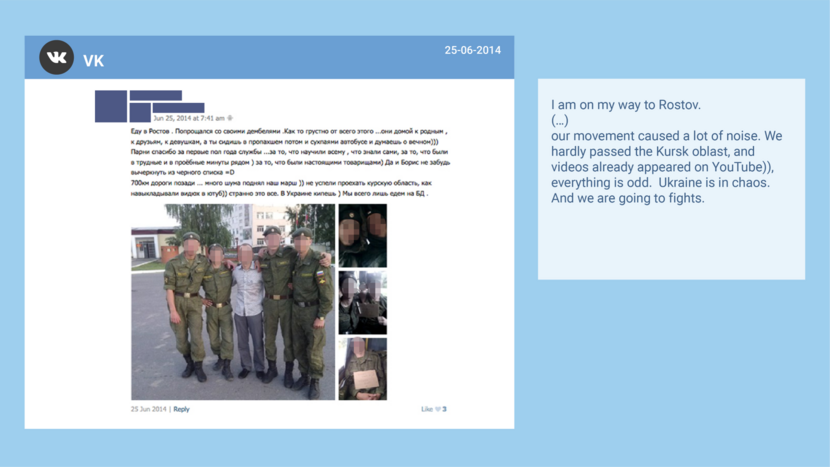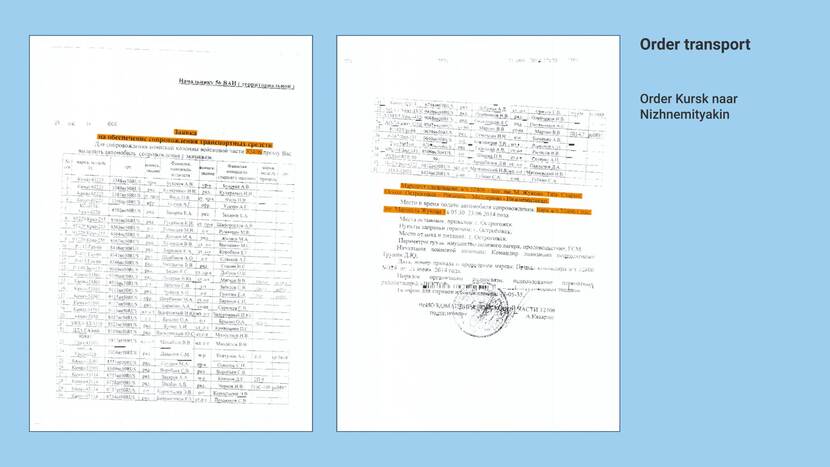Closing speech of the Public Prosecution Service day 2 (21 December 2021)
On Monday 20 December, Tuesday 21 December and Wednesday 22 December 2021 the Public Prosecution Service presented its closing arguments in the MH17 case. For the presentation on day 2 please read the text below or watch the video (in Dutch with English interpreter).
3.5 Downing of flight MH17 with the Buk TELAR
3.5.1 Introduction
And so, at the instruction and under the supervision of the four defendants, the Buk TELAR was transported to the launch location in the vicinity of Pervomaiskyi. At this point, the wiretap on Kharchenko’s number went silent. Kharchenko could no longer be heard on intercepted calls after 14:10; Pulatov went silent after 13:36. Historical telecom traffic data for the number ending in -511 showed that on 17 July 2014 from 15:48 until 16:31 it was transmitting to phone masts in Pervomaiske, close by Pervomaiskyi. But no conversations were intercepted, so further more: radio silence. Nevertheless, the investigation did produce a great deal of information about what occurred at this location.
3.5.2 Firing of the Buk missile
For example, eye witnesses reported seeing a missile launch in this location on 17 July 2014, and photos showed a missile smoke trail, while satellite photos revealed traces of the launch.
3.5.2.1 Witnesses at the launch location
Two witnesses saw a Buk missile launched from the agricultural field at Pervomaiskyi: X48 and M58.
3.5.2.1.1 Witness X48
Witness X48 was positioned at a DPR checkpoint (‘blockade point’) on the through road from Snizhne to Saur-Mogila. There are fields and rows of trees across this landscape. When he was examined by the examining magistrate the witness marked this location on a map.
He saw a dark green Buk driving, and five or six minutes later heard an explosion. Above his head a missile trail appeared, and he then heard a second explosion in the air. He saw pieces of an aircraft falling to the ground in a fan shape. The Buk then drove to the road. It was now missing one of its missiles. X48 also described four soldiers who caught his attention. They looked different from the soldiers at the checkpoint, and wore helmets with ‘ears’. Investigation revealed that within a TELAR the crew communicates using a ‘tank helmet’, a protective helmet with covered earphones and an audio link. After the aircraft wreckage hit the ground, these four soldiers moved off in the direction of the checkpoint. The witness saw the launch location burning and later being ploughed over by a tractor.
3.5.2.1.2 Witness M58
Witness M58 was also present at this location. He stated that the day before the disaster involving the Boeing, he and other volunteers from Marinovka were taken to a crossroads south of Snizhne in order to repel a breakthrough by Ukrainian fighters. This was a crossing of a paved road with an unpaved road. At the crossroads, witness M58 saw a checkpoint (‘a block point’), trees, fields with crops including wheat, and (in the distance) hills. The checkpoint was located on the paved road. After he arrived the witness helped to set up one or two tents, and he dug trenches. The next day the witness saw and heard a vehicle pass by, which he later recognised as a Buk TELAR. Shortly thereafter, he heard an explosion and saw a missile shoot into the sky in the direction of a large aircraft. He saw that the missile left a trail behind it, like you would see behind an aircraft. The witness stated that the aircraft was hit and then fell to the ground. He continued watching as the plane fell as smoke accumulated. He saw the Buk TELAR standing in the field, and later saw it at the crossroads. At that point he saw that one of its missiles was missing. He believes he also saw painted-over digits on the left side of the TELAR, one of which he thinks had been a ‘2’. After the downing of the aircraft, there were several fighters at the crossroads. On various occasions the witness marked the spot where he saw the Buk TELAR standing in the field. This point varies from closer to the crossroads to a little further from these crossroads, close by the point identified by X48.
Speaking in 2019 about the reaction to the downing of the aircraft, witness M58 told the examining magistrate the following:
‘We were really happy, because they told us that a military transport aircraft had been hit. That’s what everyone said, including the commanders. (...) I also spoke to someone who was their commander, a well-built fellow, someone local, a Ukrainian. He said: we’re heading to the spot where the plane crashed, and like us he was happy. They drove away. (…) About an hour later, or maybe a bit more, they returned, looking really sombre. I asked: what’s going on? He said: it isn’t a military aircraft. He said: There are all these...’
Witness M58 was in tears before the examining magistrate as he finished his sentence:
‘He said, there are all these children’s toys lying around.’
In late 2020, too, the witness became emotional when he concluded his four-day examination by expressing his sympathy for all the victims and next of kin.
The testimony of witnesses X48 and M58 about the missile launch at the location in question is supported by various statements given by witnesses in the area, by photos of the smoke trail coming from the location described by X48 and M58, by satellite images and – as regards the deployment of a Buk missile – the results of the forensic investigation.
3.5.2.2 Other witnesses to the flight of a missile
At the time of the missile launch, flight MH17 was flying at an altitude of around 10 km and around 34 km to the northwest of the location identified by witnesses X48 and M58. Around 32 seconds elapsed between the moment the missile was launched and the moment it hit MH17.
A large number of witnesses gave statements about a missile launch in the vicinity of Snizhne, Torez and Pervomaiskyi.
Twelve of these witnesses mentioned a smoke trail in this connection. Eleven witnesses who mentioned an explosion or smoke trail also mentioned a Buk installation they had either seen earlier that day or had heard about. And in regard to the appearance of the smoke trail, a number of witnesses specifically mentioned the hill, Saur Mogila, to the south of Snizhne, as well as the towns of Pervomaiskyi and Pervomaiske. These statements do not in themselves provide evidence of the launch location, but they correspond closely to the statements given by witnesses X48 and M58.
3.5.2.3 Photos of smoke trail
At 16:20 a resident of Torez, whose name is mentioned in the file, heard two heavy explosions within a short period of time. The second explosion was much louder than the first; so loud, in fact, that it made the window panes shake. This resident grabbed his Nikon camera and went to the balcony of his apartment, where he saw a trail of smoke coming from an object he did not recognise. The trail rose directly over his home. At 16:25 he took two photos of this trail. One of these photos, together with a version of the same photo whose contrast has been adjusted by the KNMI, is shown here.
3.5.2.3.1 Metadata
The photographer made his camera and memory card available for investigative purposes. Analysis of the metadata showed that the photos of the smoke trail were taken at 16:25:41 and 16:25:48.
3.5.2.3.2 NFI investigation into photos’ authenticity
The NFI examined the camera and memory card and no indications that the image had been manipulated were found. The NFI further concluded that the photo files were in consecutive order and that the metadata saved in the NEF files indicated the use of a Nikon camera. The same type of camera that the photographer provided and that he said he had used to take the photos.
3.5.2.3.3 KNMI investigation into smoke trail\
In addition, the KNMI examined the image of the white smoke trail on one of the two photos. Since the trail is clearly vertically oriented and is thickest at the horizon, the KNMI ruled out the possibility that the trail originated from an aircraft at high altitude. The KNMI further concluded that the cloud pattern on the photo was consistent with the cloud visible on satellite images on the afternoon of 17 July 2014.
3.5.2.3.4 Investigation into origin of smoke trail
The KNMI also investigated the direction of the smoke trail. On the basis of the landmarks visible on the photo and the coordinates of the photographer’s location, the KNMI was able to establish the orientation of these photos. The same research was also performed by a private blogger, the investigative collective Bellingcat and the investigation team itself. All this research led to the conclusion that the photos of the smoke trail were taken from a south-easterly direction from a flat north of Torez, and that the path of the smoke trail was consistent with a missile launch in the agricultural field near Pervomaiskyi.
3.5.2.4 Satellite images of marks in agricultural field
It also follows from satellite images of the agricultural field near Pervomaiskyi that the missile was fired from this location.
3.5.2.4.1 Scorch marks
When a Buk missile is being launched, the soil on which the TELAR is standing could catch fire. In satellite images taken on 20 and 21 July 2014, the northwestern corner of this field was black. This was not the case in the satellite photo of 16 July 2014. A dark line is visible on the black part of the field. According to an image analyst from the Ministry of Defence, this dark line was a consequence of the ground being ploughed. This is consistent with the statement by witness X48 that the place where the missile was launched caught fire and was later ploughed over by a tractor. The European Space Agency (ESA) also assessed the satellite images. According to ESA the visible change in the northwestern corner of the field was consistent with the effects of fire. Furthermore, in principle ESA saw no reason why a farmer would burn or plough the field in such an uneven manner. ESA could find no examples of the field being worked in such an uneven manner in older satellite images of the field. ESA therefore concluded that an abnormal occurrence had taken place in the northwestern corner of the field between 16 July and 21 July 2014, causing significant damage to the ground, including fire. This is consistent with a missile launch.
3.5.2.4.2 Fire’s point of origin
Working on the hypothesis that the black mark in the field was a burn mark, the KNMI investigated where the fire’s point of origin was and how the fire had spread from there.
The KNMI observed that at 16:20 (UTC+3) on 17 July 2014 there was a northeasterly to easterly wind in the region. If a fire originates in one spot, its seat will move with the wind, which may make the seat wider. This means that a fire burning in a northeasterly to easterly wind could expand in a southwesterly to westerly direction. If the fire started at around 16:20 on 17 July 2014, then of the locations supplied by the police only location B (or somewhere in the vicinity of location B) is a logical point of origin. Location B is the place where, according to X48, the missile was launched.
3.5.2.4.3 Tread marks
Besides showing a burn mark, the satellite images of 20 and 21 July also show tread marks that do not appear on the satellite photo of 16 July 2014. The most striking tread mark can be seen at the spot identified by X48 as the launch location.
This mark is over three metres wide and runs from the edge of the woods a short way into the field. The chassis of a TELAR is 3.25 m wide. According to the aforementioned image analyst from the Ministry of Defence, the track appears to be too wide for a mowing machine and is more consistent with a vehicle on caterpillar treads that drove into the field from the woods and then returned via the same track.
Witness M58 stated that he heard the TELAR driving alongside the trees on the northern side of the field prior to the missile launch, that the TELAR remained beneath the shadow of the trees after the missile was launched, and that it then drove to the crossroads.
The satellite image of 20 July 2014 also showed marks at the crossroads which are absent on the image of 16 July 2014. The Ministry of Defence image analyst identified possible tread marks that approached the crossroads from the north and turned in a large arc towards the launch location. These tracks therefore run from the paved road to the unpaved road, or vice versa. These track marks dovetail precisely with M58’s statement.
3.5.2.4.4 Tents
As mentioned previously, M58 also stated that the day before the downing of flight MH17 he had set up one or two tents in the vicinity of the crossroads. On the map he drew these in the upper left corner of the crossroads.
On 9 February 2019 M58 sent the investigation team a photo of a similar tent with the comment: ‘We had two tents like this at the checkpoint!’ The tent in question was a circular, light-coloured army tent. In exactly the same location as where M58 had drawn two tents, the satellite photos of 20 and 21 July 2014 show two white, circular spots which were not visible on the image of 16 July 2014. Although the presence of tents says nothing about whether or not a missile was launched, this finding is relevant to the assessment of the reliability of M58’s statement.
3.5.2.5 Video of and witness to mark in agricultural field.
In addition to satellite images of this location we also possess video images filmed by a British journalist.
On 22 July 2014 this journalist travelled with a colleague to an area south of Snizhne, in search of a launch location. In a grain field they ask the driver of a combine harvester whether he has seen a missile launch installation. The farmer points them in the direction of a piece of land a short distance further, which according to him has been burned. In this agricultural field the journalist sees that the grain is scorched. It is, he says, as if there has been a fire blast causing the crop to burst into flame. They film the location and then drive on further on an unpaved rural road. Further up the road they come to a rebel-controlled checkpoint concealed in the trees. It is positioned by a crossroads and, according to the journalist, looks as if it is a permanent checkpoint. The journalist mentions the coordinates where he saw the ‘burn mark in the field’. This spot is located in the top-left corner of the field that X48 and M58 mentioned in their statements and which can be seen in the satellite images 20 and 21 July 2014, though not in the image of 16 July. The location of the checkpoint mentioned by the journalist is also consistent with the statements of witnesses X48 and M58.
3.5.2.6 Sub-conclusion
We will now summarise the foregoing. If we trace the route of the Buk TELAR convoy and listen to the intercepted phone conversations about its destination, we end up in an agricultural field nearby Pervomaiskyi. Various witnesses saw that the Buk TELAR did actually fire a missile from there on the afternoon of 17 July 2014. First and foremost, X48 and M58 were present at the launch location that very afternoon. In addition, many other witnesses saw a missile, or something that looked like a missile, in flight. One of them took two photos of it, showing a vertical smoke trail that could not be from an aircraft and that was travelling from the direction of the same field near Pervomaiskyi that X48 and M58 spoke about in their statements. The TELAR and the Buk missile left traces behind – burn marks and tread marks – which can be seen on satellite photos and a video. Those traces correspond to what witnesses X48 and M58 observed in that field.
3.5.3 MH17 was hit by a Buk missile
It is clear from the forensic evidence that MH17 was subsequently hit by this Buk missile. During the consideration of the merits of the case, the court paid close attention to the forensic investigation. We will now discuss the key results that unmistakably indicate the use of a Buk missile.
3.5.3.1 General damage pattern
First of all, this is the pattern of damage observed on the wreckage of MH17, and more specifically the hundreds of small and larger perforations, dents, damage caused by a glancing impact and soot marks concentrated on the left and upper sides of the cockpit. This damage pattern was not found on the right side of the aircraft. The concentration of the damage on the left side visibly decreases towards the rear. According to experts from the Russian firm Almaz-Antey (AA), the Netherlands Aerospace Centre (NLR) and the Belgian Royal Military Academy (RMA), this damage pattern is consistent with the use of a Buk missile.
Research by the NFI concluded that most of the dents and perforations were the result of impacts by steel objects. A Buk missile warhead contains pre-formed steel fragments. Further research showed that the elemental composition of the steel fragments found in the dents and perforations was consistent with that of the pre-formed fragments from a Buk missile warhead.
3.5.3.2 Metal fragments
Secondly, we would draw the court’s attention to the metal fragments found in victims’ bodies, flight documents and wreckage.
3.5.3.2.1 Metal fragments in bodies, flight documents and wreckage
A total of 370 fragments were found in victims’ bodies, flight documents and wreckage.
The NFI selected a number of these for further investigation. These fragments were then compared with fragments from six 9N314M warheads, including fragments secured after the arena tests in Ukraine and Finland. A total of 195 fragments were examined.
The NFI concluded that:
- all the fragments examined were made of unalloyed steel and had an elemental composition consisting of iron with traces of silicon, chromium, manganese and copper;
- all of these fragments were produced by cutting, sawing or chopping hot-rolled low-carbon ferritic steel bars. They were then sandblasted and rinsed or otherwise treated with phosphoric and/or sulphuric acid;
- all of the fragments examined have a microstructure that is largely determined by compression of the steel during the explosion, on impact with the aircraft and through heating around the edges during the explosion and impact.
In other words, all of the fragments examined are consistent in terms of their elemental composition, production process and microstructure.
3.5.3.2.2 Bowtie- and tile-shaped fragments in bodies of crew members
The NFI also concluded that the fragments examined had three distinct shapes: bowties, tiles and rectangles. On the basis of NFI forensic photos and microCT images, two of the fragments examined by the NFI are clearly recognisable as being bowtie- and tile-shaped, even to a layperson. We can see this right now.
The Russian Federation and Almaz Antey provided information on the shape and dimensions of the fragments from the 9N314M warhead: the dimension of the bowtie is 13X13X8,2 mm, the dimension of the square is 8X8X5 mm and the dimension of the filler is 6X6X8,2 mm. These dimensions are virtually the same as those of the fragments secured after the dismantling of a 9N314M warhead in Ukraine, as established by the JIT. The forensic photos with the ruler we have just exhibited show that the bowtie and tile fragments found at the crash site have the same dimensions as the same-shaped fragments from the 9N314M warhead of a Buk missile. They also resemble the bowties and tiles secured after the arena tests in Finland and Ukraine.
These two fragments were found in the bodies of two crew members:
i. the bowtie in the body of the captain of team A;
ii. the tile in the body of the first officer of team A.
Layers of melted cockpit glass were found on these two fragments. According to the NFI, this can only be explained by the fact that the fragments came from outside the aircraft.
The Buk TELAR that we see on the films of 17 July 2014 can launch three types of Buk missiles: the 9M38, the 9M38M1 and the 9M317. These missiles are equipped as standard with their own warhead: the 9N314, the 9N314M and the 9N318, respectively. Although developed for the 9M38M1 missile, the 9N314M warhead also fits on a 9M38 missile. This was established during the dismantling of a 9M38 missile and was confirmed by the experts from Almaz-Antey and the RMA when they were examined by the examining magistrate.
According to Almaz-Antey, the shapes and dimensions of the fragments are specific to each type of warhead. The bowtie, for example, is only found in the 9N314M warhead. According to the RMA’s expert, too, the bowtie fragments are unique to the 9N314M warhead of a Buk missile.
3.5.3.3 Other missile parts
Besides metal fragments, materials from a source other than the aircraft and consistent with a Buk missile were found lodged in the wreckage of MH17.
A foreign object in the form of a piece of stainless steel was found in part of the aircraft’s metal frame on the left side of the cockpit (AAGK3338NL). A twisted piece of dark green metal was found in the groove of the frame of the left cockpit window (AAHZ3650NL). Both objects were embedded in the aircraft wreckage. In the case file they are also referred to as the ‘lump’ (from the aircraft’s frame) and the ‘green lump’ (from the window frame groove). The NFI removed these objects from the wreckage. The lump from the frame was then sawn into three pieces. All parts were subsequently examined by the NFI and by forensic specialists from the Australian Federal Police (AFP). We will first discuss the NFI investigation.
3.5.3.3.1 Elemental composition and microstructure
The NFI determined the elemental composition and microstructure of these fragments. Both consisted of hot-rolled martensitic stainless steel. The NFI also determined the elemental composition and microstructure of various parts from several reference Buk missiles, such as the umbilical base plate and umbilical slide cover. These slide covers and base plates are located on a contact point in the tail section of a Buk missile to which the cable of the Buk launch vehicle is connected. On the basis of their elemental composition and microstructure, the object from the aircraft’s frame and the object from the cockpit window frame groove cannot be distinguished from material in the slide covers and umbilical base plates of the 9M38 reference missiles and one of the two 9M38M1 reference missiles. In other words, according to the NFI these objects must have been produced using the same material as the slide covers and umbilical base plates of these reference missiles. These are either from the same stainless steel plate or from multiple plates that are identical on the basis of their composition. In these types of investigations the NFI often uses a number of hypotheses. The results of the investigation are then used to determine the probability or improbability of a particular hypothesis. In this case, according to the NFI the findings are much more likely (i.e. much more explicable) if these fragments came from the slide cover and umbilical base plate of a Buk missile than if they came from a different source, such as another weapon.
3.5.3.3.2 Other physical characteristics
As well as the NFI’s comparison on the basis of elemental composition and microstructure, the AFP physically compared these stainless steel objects from the aircraft’s frame and window frame groove with the slide cover and umbilical base plate of a Buk missile. We will now explain how the AFP has conducted this investigation and will show this with images of the green lump from the cockpit window frame.
Firstly the AFP measured and described, noting the weight, shape, colour and dimensions of this green lump. Then it was noted that it is magnetic. Furthermore it was discovered that this lump has torn edges, exhibits signs of machine tooling, and has smooth surfaces, a machined hole and ‘folded’ edges.
There is in any case a green milled plate, and underneath it a silver-coloured plate with holes. This green plate has a pre-formed edge and is approximately 1.8mm thick. The sides of this edge appear to have been rounded off by hand. Two parallel stripes can be seen on the surface, with a space of around 25mm between them, and positioned perpendicular to the pre-formed edge. There are also arc-shaped milling marks visible, running in the same direction as the parallel stripes. The back of this piece is not painted and appears smooth.
In the silver-coloured plate there is a hole with a diameter of approximately 6mm. The edge of the hole is around 3.4mm from the pre-formed plate edge. Fine stripes are visible on the plate. After its examination the AFP concluded that the green and silver-coloured plate formed a single whole.
In total the AFP established 32 points on the basis of which the metal lump could be compared to the reference material, consisting of the umbilical base plate of a 9M38 and a 9M38M1 missile.
When examining this reference material it is immediately noticeable that one side of both base plates is green and the other side silver-coloured. It is also noteworthy that the plates have been milled in a certain way and contain holes. We will show these milling marks later. The base plates also have a guide rail on both sides.
This guide rail allows the slide cover to move back and forth. After the AFP had provided an in-depth description of the umbilical base plates, it went on to compare them with the green metal lump. The similarities observed were described in detail and shown in comparison charts. We will show a few of those again now.
Here on the left we see part of the green plate and on the right part of the umbilical base plate of the 9M38 reference missile. On both parts several arc-shaped milling marks (#4, #7 and #8) can be seen side by side. They all have the same width and they all form the same fan-shaped pattern. The previously mentioned stripes (#5 and #6) can be seen on either side of the milling marks.
On the following comparison chart we can see the pre-formed edge (#9) of the green plate and the pre-formed edge of the reference material. The sides of both edges (#3 and #17) appear to have been rounded off by hand and match in terms of thickness.
Here on this comparison chart on the left we see the silver-coloured plate of the metal lump and on the right part of the umbilical base plate of one of the reference missiles. A machined hole can be seen in both plates. They are positioned the same distance from the pre-formed edge (#14). On the next chart, once more we see the whole (#10) but we also see the same type of milling marks (#32) on both plates.
And on the last comparison chart here (44) the end of the guide rail (#19) can be clearly seen on both parts.
To the left of this is the pre-formed hole (#10), which in this photo of the reference material is only visible as a light mark but which is clearly visible if viewed in person. It was described by the reporting officer. The pre-formed edge (#14 with the rounded off sides (#15, #16 and #23) can also be seen.
As regards the green and silver-coloured plate from the metal lump from the window frame groove, the AFP concluded that these originally formed a single whole and that the external characteristics of this lump match a specific part of the umbilical base plate of both the 9M38 and the 9M38M1 reference missiles.
The AFP did the same with other retrieved missile parts, including the aforementioned metal lump from the aircraft frame, which was cut in three parts. On the basis of this comparative analysis the AFP concluded that the external characteristics of the three parts of the metal lump recovered from the aircraft’s frame are consistent with a specific part of the slide cover of both the 9M38 and the 9M38M1 reference missiles.
3.5.3.3.3 Summary of other missile parts
In summary, the following was established with respect to these two foreign objects, i.e. the lump recovered from the aircraft’s frame and the lump recovered from the window frame groove. Both objects were embedded in the wreckage. In both cases the wreckage had to be sawed in order to remove the metal lumps. The NFI established the elemental composition and microstructure of both objects. These are consistent with the elemental composition and microstructure of the umbilical base plate and slide cover of the 9M38 and 9M38M1 missiles. The AFP determined the external characteristics of these metal lumps and compared them with those of the umbilical base plate and slide cover of the reference missiles. It concluded that there are a great many similarities. The metal lump in the aircraft’s frame was recognised as part of a slide cover and the lump in the window frame groove as part of an umbilical base plate.
The distortion of these two lumps and the manner in which they were embedded in the wreckage also convinced the RMA expert that their presence in the wreckage was the result of an explosion. They could not have been embedded into the wreckage in a static manner. Furthermore, according to the RMA these objects are unique to a Buk missile.
3.5.3.4 Sub-conclusion
From a forensic perspective, the circle is thus complete: the damage pattern made up of hundreds of small and larger perforations and dents is consistent with the detonation of a Buk missile warhead in the vicinity of MH17. Traces of steel in those perforations and dents have the same elemental composition as the fragments from a Buk missile warhead. In the wreckage of MH17 and in victims’ bodies steel fragments were found that in terms of their elemental composition, microstructure and production process are consistent with the fragments from a Buk missile warhead. Cockpit glass was found on some of those fragments. Fragments were found in the bodies of the captain and first officer that were bowtie- and tile-shaped, as established by the NFI. According to Almaz-Antey, bowtie-shaped fragments are only found in 9N314M warheads. This has been confirmed by the RMA and NLR experts. All the experts have further stated that a 9N314M warhead fits on both the 9M38 and 9M38M missiles. Parts from these types of missiles were found embedded in the wreckage of MH17. On the basis of these findings and the forensic investigation there can be only one conclusion: flight MH17 was downed by a Buk missile.
3.5.4 Conclusion
To summarise once more: the Buk TELAR was transported to the launch location near Pervomaiskyi at the instruction of and under the supervision of the defendants. This follows from the route taken by the convoy, which can be reconstructed in detail on the basis of mobile phone mast data, witness statements, social media posts and videos and photos of the Buk TELAR. It also follows from intercepted conversations in which Pervomaiskyi is mentioned as the final destination. Shortly before 14:07 the Buk TELAR reached its destination.
Two eye witnesses then saw the Buk TELAR fire a missile from an agricultural field near Pervomaiskyi, and various other witnesses in the vicinity observed the Buk missile in flight. One of those witnesses also took photos of the vertical smoke trail left by the missile, coming from the direction of the agricultural field near Pervomaiskyi. In the same field various traces were found: scorch marks from the ignition of the missile and tread marks from the Buk TELAR. Also traced afterwards was the checkpoint mentioned earlier that afternoon (at 13:09:27) by a subordinate of Kharchenko as a point of orientation for the final destination of the Buk TELAR and which was seen near the launch location by both eyewitnesses.
Finally, the fact that MH17 was indeed hit by a Buk missile is evidenced by the findings of the forensic investigation. In short: the damage pattern on the left and upper sides points to the detonation of a Buk missile warhead. Hundreds of fragments from a source other than the aircraft itself were found in the wreckage of MH17, flight documents and victims’ bodies. These fragments each have specific similarities with various parts of a Buk missile or a 9N314M warhead. Investigators found no evidence of a different weapon having been used.
The Public Prosecution Service therefore concludes that on 17 July 2014 flight MH17 was downed by a Buk missile launched from a Buk TELAR in an agricultural field near Pervomaiskyi.
3.6 Reactions to the downing of MH17
3.6.1 Introduction
The launch of the Buk-missile and the downing of MH17 produces many reactions that day. The defendants and other fighters discussed the incident primarily by phone. Local residents and journalists reported on it via social and other media. We will now take a general look at these reactions, because they tell a story about the involvement of the DPR in general and the involvement of the defendants in particular.
3.6.2 Reports of an aircraft being shot down
As early as 16:21, one minute after MH17 was downed, various social media posts mentioned the crash or downing of an aircraft near Snizhne and Torez. At the same time, in the first 20 minutes after the disaster various phone calls took place among DPR fighters in which they discussed the fact that they had downed an aircraft. Local residents also talked on the Zello app about an aircraft being shot down. Various types of military aircraft that had allegedly been downed were mentioned in the intercepted calls and Zello chats.
A short time later, at 16:37 the following message was posted on the VK account strelkov_info: ‘A message from the people’s army. An An-26 was just downed in the vicinity of Snizhne. It lies scattered on the ground behind the “Progress” mine.’
This post was later amended, with the sentence about the downing of an An-26 in the vicinity of Snizhne being deleted. Defendant Girkin stated that the messages had not been posted by him, and this was also emphasised on the VK account itself. However, this does not make these messages any less relevant. Indeed, it is relevant that immediately after the downing of MH17 the DPR claimed that an aircraft had been shot down from the area around Snizhne. Later, on 6 February 2015, this was again confirmed by defendant Girkin during a Russian witness examination. He stated that on 17 July 2014 at around 16:30 Moscow time he had received a report that an Su-25 belonging to the Ukrainian air force had been downed near Snizhne by ‘the air defence’. We will return to this statement later when we discuss the various standpoints of the defendants.
The fact that the DPR actively communicated about having downed an aircraft was confirmed by a French photographer in the area. In a video statement posted online he explains that he was called by the DPR press officer, who said: ‘We shot down a military plane from Ukraine’. He interpretes this as an invitation to report on the incident and goes to the crash site. On his way there, he receives information that it concerns a civilian aircraft from Malaysian Airlines.
3.6.3 Intercepted conversations about the Buk and downing of a Sushka
The first intercepted conversation after the downing of MH17 in which the defendants took part was at 16:48. This was less than 30 minutes after the incident. In this conversation Kharchenko tells Dubinskiy that they are ‘on the spot’ and have already downed a ‘Sushka’, a nickname for a Sukhoi combat aircraft. Dubinskiy says they have done well. Dubinskiy also tells Kharchenko to come to him but to leave one company behind to guard the ‘Buk’. About thirty minutes later, Dubinskiy checks with Kharchenko whether the ‘Buk’ has been positioned so as to prevent it from coming under artillery fire.
Meanwhile, various other phone conversations were taking place between DPR fighters in which the downing of an aircraft was discussed. In some of these conversations, people were already saying that there were probably civilians on board the aircraft. At 17:42 Dubinskiy was called by the DPR fighter with the call sign ‘Botsman’. Botsman says that an aircraft has been downed near him and that he is going to get the black boxes. Dubinskiy says that they have also shot down an aircraft – a Sushka – over Saur-Mogila and that they have a ‘Buk-M’. Later in the conversation Dubinskiy says that they downed two Sushkas the day before and another one that day. Thank God the Buk-M came this morning, Dubinskiy says.
3.6.4 Intercepted conversations about the downing of a passenger aircraft
Not long after this, the defendants started to realise that they had not shot down a Sushka but rather a passenger aircraft. At 18:20 Dubinskiy called someone going by the name of Igor. Igor says that journalists are hassling him and telling him that a Boeing has crashed 80 kilometres from Donetsk. He asks Dubinskiy if it is true that a Boeing has crashed. Dubinskiy appears not to understand, to which Igor says: ‘Boeing. The plane crashed.’ Dubinskiy then says, ‘Ah, well, our guys brought it down at Saur-Mohyla, there, near Marynivka.’ Igor corrects him and says: ‘That was Sushka, Sushka’, which Dubinskiy confirms, saying: ‘Our guys brought down the Sushka.’ Dubinskiy also says that he has heard that another aircraft has crashed, but that he doesn’t know anything about it. It therefore appears that they believed that two aircraft had been downed: a Boeing and a Sushka.
Around 7.30 PM Girkin’s assistant was called by DPR fighter Anosov, who said he had a message for Girkin. News broadcaster Russia24 has called him and said that the downed aircraft was a Boeing. According to Anosov, the Ukrainians downed the Boeing. They (presumably referring to Russia24) want to be the first to broadcast the news that the Ukrainians have downed a passenger aircraft so that they can blame the militia. Three minutes after this conversation, , Dubinskiy is called by the same assistant working for Girkin. He tells him to go to Girkin. Dubinskiy says he will be there in 20 minutes.
By now it has become clear to Girkin and Dubinskiy that they have downed a passenger aircraft, a Boeing.
3.6.5 Intercepted conversations about the downing of MH17 by a Sushka and the Sushka by a Buk
At this point the defendants went into action and the gist of their conversations changed. Their new account is that MH17, the passenger aircraft, was shot down by a Ukrainian Suhka and that they then shot down that Sushka with the Buk.
This is mentioned in a conversation between Kharchenko and Pulatov at 18:44.
Pulatov says that he is driving at full speed through Torez and that he has to provide a detailed evaluation of the situation. Pulatov says that Kharchenko has to tell ‘that one’ that ‘our Buk (...)’. Kharchenko interrupts Pulatov and tells him that everything is in order and that ‘that’ (i.e. their Buk) has gone to another location. Pulatov says that the Sushka downed the Chinese passenger aircraft one minute earlier. Kharchenko carries on talking and says ‘No, no, no. We were working over the Sushka.’ Pulatov says that he knows that and that shortly afterwards they had got the Sushka that downed the Chinese aircraft. Pulatov says that the whole world will be talking about it.
Fifteen minutes later, at 19:01, Pulatov received a call from the DPR fighter Tskhe. Pulatov says that he knows that he (Tskhe) is concerned but that the aircraft that Tskhe’s blood brother shot down was a Sushka, which had shot down the civilian aircraft one minute earlier. According to Pulatov, Tskhe’s blood brother has done well and Tskhe does not need to worry. This new scenario is also reflected in other conversations between separatists.
At 19:52 Pulatov gives the same account to Dubinskiy, although it takes a while for Dubinskiy to grasp the story.
Dubinskiy asks Pulatov: ‘Was our Buk fired or not?’ Pulatov answers that ‘the Buk shot down a Sushka after the Sushka had shot down the Boeing.’ Dubinskiy asks whether Pulatov saw this himself. Pulatov says that he himself was in Marinovka, but that their (‘our’) men had seen it from all positions and that it was observed from Snizhne itself. Dubinskiy apparently still cannot quite grasp it, and asks again whether the Sushka was shot down by ‘the Buk’. When Pulatov confirms this, the situation is clear to Dubinskiy.
It is not only Dubinskiy who initially has difficulty understanding the story. This becomes apparent two minutes later, when Dubinskiy calls Girkin to tell him the news.
Dubinskiy tells Girkin’s assistant that he needs to speak to Girkin and that it is very urgent. When Girkin gets to the phone, Dubinskiy asks whether he wants to hear some good news, probably the first today. Dubinskiy says that in Snizhne ‘our people’ saw the Sushka hit the Boeing, and that ‘our people’ had then hit the Sushka with the Buk. Pulatov has reported on these events. After Dubinskiy repeats that the Sushka hit the Boeing and that their people had then hit the Sushka with the Buk he asks whether Girkin thinks it is good news. Girkin replies saying that he doesn’t know but that he honestly doesn’t believe much of it.
As adamantly as Dubinskiy reports this ‘good news’ to Girkin, he himself seems unconvinced by this interpretation of the events. This is apparent five minutes later, a little before eight, when he is called by Kharchenko.
Kharchenko asks whether he should open up the crash site to the OSCE, the European organisation present at the crash site. Dubinskiy says he should. He then asks whether Kharchenko is sure that their people saw it being hit by a Sushka, or whether it was actually their people who were responsible. Kharchenko says they were not. Dubinskiy continues to ask questions: ‘It was Sushka, wasn’t it?’. Yes, it was a Sushka, Kharchenko says. ‘And then the Sushka was hit with a Buk by our people. Is that right?’ asks Dubinskiy. ‘Yes, first there was a bang in the sky and then our bang,’ Kharchenko confirms.
3.6.6 Conclusion
In the hours following the downing of MH17 there was a considerable amount of communication between DPR fighters, including the defendants. Initially they expressed their delight over the fact that a military aircraft had allegedly been downed. They referred to ‘our Buk’ and ‘the Buk’ that downed the aircraft. Once it became apparent that a passenger aircraft had been downed, the story changed to suggest that the Boeing had been downed by a Ukrainian combat aircraft and that this combat aircraft had then been downed by the separatists using a Buk. The defendants were still referring to ‘their’ Buk as having downed an aircraft.
It is not so surprising that not everyone accepted at face value the amended story – that in addition to MH17 a combat aircraft had also been downed – and that the conversations between the defendants were awkward; after all, no military aircraft was downed that day. There was not even a military aircraft in the vicinity that could have been targeted, or that could have shot down MH17. Extensive research has shown that neither the Russian nor the Ukrainian primary radar data from 17 July contain any record of a military aircraft in the vicinity of MH17. Witness statements and flight data provided to the Ukrainian authorities confirm that no military flights were carried out above separatist-held territory that day. Furthermore, no wreckage other than that of MH17 has ever been found.
As regards the evidence against the defendants, it is not important whether they sincerely believed that they had downed a Sushka or whether this was said merely to avoid being accused of downing MH17. What is important is that immediately after the downing of MH17 the DPR fighters, including the defendants, discussed the fact that they had downed an aircraft with their Buk. And given that no aircraft other than MH17 was downed in Ukraine on 17 July 2014, their conversations could only have pertained to the downing of MH17.
3.7 Removal of the Buk TELAR
3.7.1 Introduction
We have now considered at length the transportation of the Buk TELAR to the launch location on 17 July 2014, the launch of the Buk missile from the agricultural field near Pervomaiskyi and the reactions of the defendants immediately after the downing of MH17. We will now discuss what happened after the downing of MH17, i.e. the removal of the Buk TELAR to the Russian Federation and the role of the four defendants in this operation.
3.7.2 Organisation of transportation and security of the Buk TELAR
A few hours after MH17 was shot down various telephone conversations took place between the defendants and their subordinates about the removal of the Buk TELAR.
As we just mentioned, fairly soon after the downing Dubinskiy asked Kharchenko whether he was sure the Buk was in a secure location and whether it could possibly come under artillery fire. At this point Dubinskiy does not appear to have realised that MH17 was downed by the Buk, and so the conversation is confined to whether the Buk TELAR is secure. Kharchenko assures Dubinskiy that the Buk is safe. Over three hours later (at 20:30) – once the downing of MH17 has become world news – Girkin ordered Dubinskiy to have the ‘damaged tank’ ’evacuated’, under the escort of two BTRs (armoured vehicles). A group will be waiting for them at the regional border, he says, with a crane and a low-loader. Dubinskiy says that ‘the box’ is being guarded by Kharchenko and that he also has BTRs. Girkin refers to ‘the plane’ and says that Dubinskiy needs to sort it out.
Almost immediately after the conversation with Girkin, (at 20:32:44) Dubinskiy calls Kharchenko to say that a low-loader will come for ‘the box that we have’. He passes on Girkin’s orders: their two BTRs need to escort that box to the regional border. In reply Kharchenko says that he no longer has any BTRs: one has broken down and the other has been taken by ‘Prapor’, the call sign of another commander.
In these conversations Girkin and Dubinskiy discuss a ‘damaged tank’ and ‘the box’. Given the earlier and later conversations between the defendants that show that Kharchenko’s unit was guarding the Buk TELAR at that time, and given the facts and circumstances on the evening and night of 17 to 18 July 2014, it is unmistakably clear that ‘the damaged tank’ and ‘the box’ refer to the Buk TELAR.
3.7.3 Buk TELAR drives under its own power from launch location to Snizhne
As is apparent from the previously mentioned conversation between Dubinskiy and Kharchenko, the Buk TELAR was secured immediately after the downing of MH17.
3.7.3.1 Buk TELAR drives to Snizhne under its own power and under escort
It emerged from other conversations that the Buk was subsequently escorted to Snizhne. For example, in a conversation at 20:41 Sharpov tells Kharchenko that ‘the box’ is being removed by people unknown to him and asks Kharchenko whether he needs to escort it. Kharchenko replies in no uncertain terms that Sharpov should leave it where it is (‘don’t escort anything!’) and that he, Kharchenko, will come and pick it up. In the background Sharpov can then be heard telling others that Kharchenko is on his way to escort it. It is also said that they should go to the edge of the checkpoint, where Kharchenko will be arriving.
Historical telecom traffic data shows that from 16:26 to 20:54 Sharpov’s phone is transmitting to a mast that has the launch location and the nearby checkpoint in its range. Less than 15 minutes later, Sharpov tells Kharchenko that ‘it’ is now driving towards the town under escort and anti-aircraft artillery protection. Sharpov has heard that it will be guarded by ‘his own men’ and asks whether he should follow on behind them. Kharchenko tells him to let them go.
The fact that the Buk TELAR has left for Snizhne under its own power and is being escorted and guarded is also clear from the conversation that followed between Kharchenko and Dubinskiy. At 21:13 Kharchenko tells Dubinskiy that ‘the box’ has already gone. Dubinskiy wants to know whether the box left under its own power and where it is currently located. Kharchenko says that it did indeed travel under its own power and that it is now in Snizhne, adding that it will not go to its destination under its own power. Kharchenko is ordered to leave it there (in Snizhne); Dubinskiy is going to ask Girkin what they should do now. We will now play that conversation.
3.7.3.2 Buk-TELAR crew member lost before arriving in Snizhne
A number of subsequent conversations show that one of the Buk TELAR crew members became separated from the rest of his crew. In the conversation of 21:32 Gilazov informs Kharchenko that one fighter from the ‘launcher’ ‘has fucking lost his crew’. When Kharchenko asks which ‘launcher’ he is referring to, Gilazov answers ‘the Buk’. Gilazov says that the ‘fighter’ is still with him, at the checkpoint. Cursing, Kharchenko instructs Gilazov to take the fighter to Snizhne, where Kharchenko will be waiting for him.
Almost immediately after this conversation with Gilazov, Kharchenko called Pulatov and asked him to contact the fighters from the ‘new box’. Given the previous conversation with Gilazov it is obvious that he is referring here to the Buk TELAR. Kharchenko says that they are not at the meeting point and that they have also left one crew member behind. Kharchenko says that the crew member is with him. Pulatov promises to contact the fighters. Kharchenko then says that Gilazov (‘Ryazan’) is waiting for Pulatov at the Furshet supermarket.
Immediately after this conversation, at 21:42 on 17 July 2014 Pulatov called the phone number ending on 6335 three times. Pulatov tried to contact this number before, shortly after he met the Buk convoy with Kharchenko at the Furshet. As previously discussed, the user of this number is either one of the crew members or is in contact with the crew of the Buk TELAR. In the night following the downing of MH17 Pulatov calls this number three times but there was no answer. Given the conversation with Kharchenko earlier and his request to contact the fighters form the ‘new box’, the Public Prosecution Service assumes that at that time Pulatov was trying to contact the crew of the Buk TELAR or a member of the escort team. At 21.42 and 22.52 Pulatov was called twice by Gilazov, possibly about meeting the lost crew member at the Furshet. Immediately after these calls, at 21:53 and 22:53 respectively, Pulatov tried calling the phone number ending in ‘6335’ again, again without success.
Where and when the lost crew member rejoined the rest of the crew cannot be determined from the investigation findings. However, it is clear that while Kharchenko was responsible for the removal of the Buk TELAR, Pulatov was the one who maintained contact with the crew or the escort team.
3.7.4 Transportation of the Buk TELAR from Snizhne to Luhansk
We have just discussed the departure of the Buk TELAR from the launch location and its arrival in Snizhne shortly after 21:00. The first instruction about the removal of the Buk TELAR came from Girkin and was passed on to Kharchenko by Dubinskiy.
3.7.4.1 Buk-TELAR convoy drives from Snizhne to Krasnyi Luch
Several hours later, at 23:12, Kharchenko told Dubinskiy that he was still in Snizhne and that the TELAR had just been driven onto the platform (of the low-loader).
Kharchenko says that he will have to escort the convoy to Debaltseve because nobody knows the way. When asked, Dubinskiy says that Kharchenko should leave the escorting to his (Kharchenko’s) boys. Two minutes later Dubinskiy calls Kharchenko and instructs him to drive to a crossroads north of Krasnyi Luch. He must wait there for the escort coming from Luhansk.
In this connection we would observe that the Buk TELAR would have to drive through the neighbouring Luhansk oblast in order to reach the open border crossing with the Russian Federation.
The Buk TELAR was ultimately escorted by Kharchenko’s subordinates, in line with Dubinskiy’s instructions to Kharchenko. One of them was witness S21, who drove one of the vehicles escorting the Buk TELAR and acted as point of contact for members of the LPR.
On the afternoon of the day MH17 was downed, witness S21 was at the Furshet supermarket. At the exit he spoke to two Russian-speaking men in uniform. In his statement he said that that evening Kharchenko had ordered him to escort the Buk TELAR from Snizhne to Krasnyi Luch together with some more of Kharchenko’s subordinates.
At a maintenance site for repairing equipment, located behind the Furshet, there was a low-loader carrying an air-defence system ready for departure. Witness S21 noticed the missiles’ fins and realised that it was a missile system, but only heard later from one of the escort team that it was a Buk TELAR. The two Russian-speaking men whom the witness had seen earlier that day at the Furshet were also present and got into the cabin of the low-loader. The convoy consisted of a Volkswagen Amarok, a black Volkswagen T5 and a low-loader with the Buk TELAR. According to S21 the convoy departed Snizhne for Krasnyi Luch at around 23:30.
This is consistent with the conversation that took place at 23:32 in which Kharchenko confirmed to Dubinskiy that his men had already left. Dubinskiy asks for the phone number of a senior member of the team, because this person will be called by ‘the ones from Luhansk.’ Kharchenko passes on the phone number and call sign of S21.
3.7.4.2 Planned escort of the Buk-TELAR by LPR fighters
Around the time that the Buk convoy is about to leave, the LPR fighters mentioned by Dubinskiy are preparing to meet the convoy at Krasnyi Luch and escort it onward to the border with the Russian Federation.
This is evident from the various conversations between the then self-proclaimed defence minister of the LPR, Plotnitskiy, and his deputy Bugrov. For example, in conversations at 23:34 and 23:46 Plotnitskiy tells Bugrov that a ‘Carpathian tree’ and two armoured vehicles needed escorting from the crossroads at Krasnyi Luch to the border crossing at Severny. This is where the convoy will be met. ‘Buk’ is the Russian word for beech, a common tree in the Carpathian region, hence the term ‘Carpathian tree’.
3.7.4.3 Buk TELAR convoy travels from Krasnyi Luch to Luhansk via Debaltseve
The planned meeting between the members of the DPR and the LPR and the handing over of the Buk TELAR does not ultimately take place. On the night of 17 to 18 July 2014 between 01:20 and 02:30 there are various phone calls that show that witness S21 and the rest of his group do not wait for the escort in Krasnyi Luch but instead continue immediately on to Debaltseve.
Two minutes later Dubinskiy calls back to say that he cannot get hold of Kharchenko and that he no longer knows S21’s phone number; he left it on Girkin’s table. Girkin decides to call himself. At 01:56 he says to S21: ‘The code word is 333. A guy will come along.’ Less than a minute later he adds: ‘Hello. Once again: they are to bring a barrel of diesel and after filling up they are to be escorted some distance off. Well, if they don’t bring a barrel that means they are the wrong guys. Got it?’ Within the next few minutes Girkin tries to contact S21 three more times. S21 finally answers on the fourth attempt. Girkin asks whether the handover was successful. S21 says that they are leaving for Snizhne. When Girkin asks whether he means that ‘the equipment’ has been handed over S21 replies: ‘I mean we went away in the direction of Snizhne. That’s it. Good bye.’ He then ends the call without answering Girkin’s question. Girkin therefore calls Dubinskiy immediately again. He asks whether ‘the equipment’ has now been handed over and says that it is ‘a hell of a mess’. He then gives Dubinskiy S21’s number. Dubinskiy says he has noted it and that he will call Girkin back shortly. It appears that he failed to do so, because five minutes later Girkin calls Dubinskiy again. Dubinskiy answers and says that he has not yet been able to contact S21. Girkin becomes angry and says that they have left and are heading back to the town. Dubinskiy asks why they would do that: after all, he had given them the instructions in Girkin’s presence. Girkin does not know either. What he does know is that it is a ‘hell of a mess’ and he tells Dubinskiy to sort it out. The ‘equipment’ must be handed over.
Six minutes later Dubinskiy still hasn’t been able to get in touch with Kharchenko or S21. Girkin reacts angrily. He says that the people from Luhansk came, but that one of the Dubinskiy’s men independently decided to turn back and now cannot be reached. He orders Dubinskiy to go to Snizhne. We will now play that conversation, from which it is clear that tempers are running high.
According to S21’s statement, the convoy arrived at the crossroads on the Rostov Highway near Krasnyi Luch at around 01.00 or 02.00 on the night of 17 to 18 July 2014. Around that time those escorting the Buk received several phone calls about other parties escorting the freight further but, according to the witness, no one in the group was aware of these arrangements so after a while they continued on to Debaltseve. Once they had arrived in Debaltseve, part of the convoy turned back to Snizhne. The rest continued on towards Luhansk with the low-loader carrying the Buk TELAR.
3.7.4.4 Buk TELAR convoy in Luhansk
The arrival of the convoy in Luhansk early in the morning of 18 July did not go unnoticed. The low-loader and Buk TELAR were captured there on video. This video was posted online that same day.
3.7.4.4.1 Luhansk video
The footage shows the Buk TELAR carrying three missiles, instead of four. In other words, one missile is missing. According to the metadata, this video was recorded on 18 July 2014 at 04:50:10.
This is close to the time determined by the KNMI on the basis of the images’ visual characteristics. The NFI investigated claims by the Russian ministry of Defence that this video had been manipulated. The NFI found no indication whatsoever of manipulation. On the basis of key features in the video and other image files on the memory card it was established that the video was filmed at a crossroads in Luhansk.
3.7.5 Transport of Buk TELAR from Luhansk to Russian border
From Luhansk the convoy is believed to have headed in a south-easterly direction via Sukhodilsk to Severny, the northern border crossing with the Russian Federation. This is a distance of approximately 63 kilometres.
3.7.5.1 S05’s witness statement
Witness S05 saw the Buk TELAR along this route early in the morning of 18 July 2014.
He stated that he saw the Buk missile system at around 05.20 near Molodogvardeysk. It was being transported on a trailer on the highway from Luhansk to Krasnodon. According to the witness the Buk was dark green in colour. The missiles were green with a white nose cone and were pointing in the direction the truck was travelling. He recognised the missile system as a Buk because on TV and the internet he had seen images of a Buk in Snizhne.
3.7.5.2 Chernykh calls Kharchenko
One of the men involved in the last part of the removal is Chernykh, als known as Bibliothekar. He was also involved in the transportation of the Buk to the launch location, on the route from the Russian border to Donetsk. Around the time that S05 saw the Buk on the trailer close to Molodogvardeysk, Chernykh’s phone pinged a mast (at 05.24) in the same town. No mast locations are available for this phone number between 05:24 and 07.15.
At 07:15 Chernykh’s phone pinged a mast in Severny, at the Ukrainian-Russian border. At that point Chernykh had phone contact with Kharchenko. The content of this conversation is unknown because neither of the numbers was being tapped.
3.7.6 Buk TELAR back in the Russian Federation
At 07:17, a few minutes after the contact with Chernykh, Kharchenko called Gilazov using the number that was being tapped. Kharchenko can be heard telling someone in the same room that everything is in order and that ‘the vehicle’ has reached Russia.
In the conversations that follow between the defendants they discuss the failed rendezvous and the fact that those escorting the vehicle couldn’t be reached. In a conversation at 07:41 Dubinskiy reacts to the events of the previous day. He is clearly irritated. He asks Kharchenko why S21 turned back. Kharchenko says that they escorted the vehicle to the crossroads and that the boys continued on their own. Kharchenko then says that the vehicle has arrived in Russia. A few minutes after the conversation with Kharchenko, Dubinskiy receives a call from Girkin. Dubinskiy says that the vehicle has been in Russia for some time and that everything went well.
Girkin asks Dubinskiy who S21 handed the vehicle over to. A few minutes later Girkin calls Dubinskiy again and tells him to send S21 to him. Immediately after the conversation with Girkin, Dubinskiy calls Kharchenko again. He says that Kharchenko needs to fetch S21 and bring him to him to explain who took the vehicle and where it was taken. According to Kharchenko it went to Bibliothekar, aka Chernykh, part of the group that had loaded the vehicle onto the trailer. They are now in Russia and are bringing along a new vehicle. We will now play that conversation.
Dubinskiy then calls Chernykh himself and asks whether ‘our men’ handed over the ‘box’ to him. Chernykh confirms this and says that he exported it and that it ‘is already there’, meaning the Russian Federation. Dubinskiy then informs Girkin that Chernykh received the vehicle from S21 and took it to the border area.
3.7.7 Conclusion
The Buk TELAR that was brought into eastern Ukraine in the night of 16 to 17 July 2014 was back in the Russian Federation a day later. After downing MH17, the weapon was loaded back onto the low-loader and driven to the Russian Federation under the escort of Kharchenko’s subordinates and under the direct responsibility of Dubinskiy, who was acting on Girkin’s orders.
3.8 Origin of the Buk TELAR
The intercepted calls and mobile phone mast data we have just discussed show that the Buk TELAR that was brought in on the morning of 17 July 2014 and removed again after the launch, came from the Russian Federation. Furthermore, this Buk TELAR has been identified as a TELAR belonging to the 53rd Anti-Aircraft Missile Brigade (which we will refer to as the 53rd Brigade) from Kursk in the Russian Federation. This identification took place in several steps.
3.8.1 Comparison of visual material from 17 and 18 July 2014
3.8.1.1 Ukrainian visual material
The first step in the identification process was the examination of the visual material of the Buk TELAR from 17 and 18 July 2014, which we will refer to hereafter as the Ukrainian visual material. The same Volvo truck and low-loader with the Buk-TELAR can been seen in visual material from Donetsk (I), Makeevka, Torez and Luhansk. A Volvo truck with a white cabin and a red low-loader is visible in all of this visual material.
In each case a blue stripe can be seen on the side of the cabin, with a (yellow and black) image above the blue stripe. In all of the visual material there are two orange flashing lights on the roof of the cabin, and on each side of the red low-loader there is a yellow sign with a telephone number printed in black. This white Volvo truck with low-loader appears to have come from the firm Budmekhanizatsiia in Donetsk. The firm’s owner recognised his truck in the visual material mentioned.
Furthermore, in the visual material from Donetsk, Makeevka and Torez, as well as that from Zuhres, a dark-coloured delivery van can be seen along with one or more escort vehicles. One of the other escort vehicles was a dark- or green-coloured jeep, also referred to as a UAZ in the case file. This can be seen in the visual material from Donetsk, Makeevka and Torez, as well as in the photo taken in Snizhne and posted on the Russian social media forum VK on the evening of 17 July 2014.
The Public Prosecution Service therefore concludes that the same military convoy – and thus also the same Buk TELAR – can be seen in all the visual material from 17 and 18 July 2014. The visual material from Donetsk (I and II), Makeevka, Torez and Luhansk is of such a high quality that a total of 15 specific features of the TELAR are recognizable. These are primarily traces of usage: features that point to wear and tear, transport or logistical markings for operational deployment. These include multiple transport markings and white stripes (or marks) in a place where tactical vehicle numbers are generally found. There was also a tear or opening in the rubber side skirt. And there is one anomalous road wheel on the right side of the TELAR.
This last feature is particularly identifying. In this investigation we only encountered two types of road wheels: with and without spokes. Generally a Buk-TELAR has one type of road wheels on each side: with spokes of without spokes. So, one divergent road wheel is special. Because the road wheels on the visual material from Ukraine is not always clearly visible, I now will explain how this deviation can be recognized.
If the sun hits a TELAR at a certain angle, a shadow can be seen in the wheel wells. Both the hub cap and the spokes in those wheel wells have an influence on the shadow. As a result, the road wheels with spokes cast a different shadow than the wheels without spokes. The shadow of the closed wheel is wider than that of the spoked wheels. On the basis of the differences in the shape of the shadow, it is possible to distinguish between the different types of road wheels.
The visual material from Torez shows the right side of the TELAR. In this image we see that all the road wheels have spokes, except for one: the second wheel from the rear, the second wheel from the left as we look at it.
Because the position of the sun and the shadows makes it difficult to distinguish the individual road wheels, the width of the shadow visible in each wheel was measured on the basis of the true dimensions of the road wheels.
On the basis of those measurements it is clear that the shadow cast by the second-to-last road wheel is substantially wider than that of the others. The width of the shadows in the other road wheels varies from 12cm to 15cm, while the shadow in the second-to-last road wheel is 23cm wide.
The calculations show an objective difference between the second-to-last road wheel and the other road wheels. Due to the distinguishing character of this feature, the shadows in the various road wheels were examined in more detail.
For this purpose 3D scans were made of Buk road wheels with and without spokes. These scans were then fed into a computer program that can run shadow simulations. By inputting the date, time and location of the TELAR’s position, it is possible to generate a simulation of the type of shadow cast by each type of wheel, using the actual weather conditions and position of the sun on the day in question. We will now show the results of that simulation.
If we now look once again at the visual material from Torez and compare it to the simulation of the shadow based on the actual position of the sun on 17 July 2014 at the recording location, it can clearly be seen that the shadow of the second-to-last road wheel – the right wheel as we look at it – is wider than the shadow in the other wheels, and is therefore a different type of road wheel.
We have now shown a number of features. A detailed description of all features can be found in an overview that will be appended to this closing speech. On the basis of the combination and location of all of these features, this Buk TELAR can be identified with a high degree of certainty. To establish the origin of the TELAR, the investigation team went in search of other visual material of a TELAR with exactly the same combination of features.
One of those other features is a white transport marking on the rubber side skirt. In the Russian Federation these kinds of markings are applied to military vehicles being transported by train. Due in part to this indication, investigators looked for visual material of Russian military materiel when searching for the same Buk TELAR.
3.8.1.2 Searching for the same TELAR in other visual material
On the internet visual material was found of a large military convoy that from 23 to 25 June 2014 was travelling south from Koersk in the Russian Federation along the Russian-Ukrainian border. The convoy, which comprised a complete Buk system including six TELARs, was last captured on film in Millerovo in the Russian Federation. The visual material consists of 21 video files and nine social media posts containing one or more images. We will hereafter refer to this as the Russian visual material.
The convoy included a Buk TELAR with a tactical vehicle number beginning with 3, followed by a small white stripe and ending in 2. This vehicle is also referred to as ‘3X2’. The most striking feature is that this TELAR also has one road wheel without spokes. This is clearly visible in the visual material from Stary Oskol.
The similarity with this distinctive feature necessitated further examination of ‘3X2’. This closer examination led to the conclusion that this TELAR has 14 of the 15 features visible in the visual material from Ukraine. The 15th feature in the Ukrainian visual material – a diagonal stripe left over from a tactical vehicle number on the left side of the TELAR – is not present on the ‘3X2’. Instead there is an almost complete vehicle number: a 3, followed by a small white mark and then a 2. This small white mark can also be seen in the Ukrainian visual material, next to the diagonal stripe. If we take a closer look at the shape of this diagonal stripe we see that this corresponds exactly with the shape of the 2 in the tactical vehicle number of ‘3X2’. This can be seen here.
If a vehicle is to be deployed in an operation, it is common practice to sand away or paint over the tactical vehicle number so that it cannot be identified. Because the contours of a 2 are still clearly visible (particularly in the visual material from Makeevka), the Public Prosecution Service concludes that what can be seen in the Ukrainian visual material – the white mark and the diagonal stripe – are the remnants of tactical vehicle number ‘3X2’. This explains the only discernible difference between the two TELARs.
When comparing features, it is important to look not only at whether they match but also at whether they are in the same position on the TELAR and the same position in relation to each other. And that appears to be the case not only with the remnants of the tactical vehicle number shown here, but also with all of the other features. We will show a few more examples here. Each slide shows a still from the Ukrainian visual material and a still from the Russian visual material.
On the first slide we can see a centre-of-gravity marking and a train transport marking adjacent to each other on the left side of the TELAR.
On the next slide we see a train transport marking on the right side of the TELAR which – unlike the marking we just saw – is located on the rubber side skirt.
Also on the right side we see just two white marks in the place where the tactical vehicle number is typically found. Unlike the remnants on the left side that we saw previously, these are positioned not next to each other but one on top of the other.
The aforementioned anomalous road wheel is also in exactly the same place on the vehicle in both the Ukrainian and the Russian visual material.
And finally, here is the tear or opening in the rubber side skirt that we mentioned earlier. Here too the tear is clearly on the same side of the TELAR and in the same place: between the road wheel without spokes and the adjacent road wheel with spokes.
Investigators thus established a match between the Buk TELAR captured in the images shot on 17 and 18 July 2014 in Ukraine and the Buk TELAR ‘3X2’ from the Russian visual material. In the opinion of the Public Prosecution Service, the combination of 15 features makes this TELAR unique.
3.8.1.3 Verification of the identification
The uniqueness of this combination became clear during the search for TELARs other than the ‘3X2’ with the same features. That was the third step in the identification process. More than one million photos and videos were secured during the investigation. The NFI developed a tool that could be used to automatically search for TELARs. From the full dataset of approximately 1.3 million images the NFI tool picked out 463.584 images.
These results were manually checked for relevance. This means that all 463.584 images were examined by human eyes. Only those showing one or more TELARs or parts thereof were selected. A total of 2481 images were labelled ‘TELAR’. This means that in all of these images one or more Buk TELARs or parts thereof are visible. These were Buk TELARs from both the Russian Federation and Ukraine. These images were examined multiple times, specifically looking for each of the 15 features. If one or more features were detected, the image was examined further to determine where exactly those features were located on that specific TELAR. This proved to be a painstaking and fruitless task: no Buk TELARs with the same combination of features as the TELAR in the Ukrainian visual material from 17 and 18 July 2014 and the ‘3X2’ in the Russian visual material were found in these images.
3.8.1.4 Sub-conclusion
The Public Prosecution Service therefore concludes on the basis of the three steps described that the TELAR that was captured several times in images shot on 17 and 18 July 2014 is the same vehicle as Buk TELAR ‘3X2’, which was captured several times in images shot on 23, 24 and 25 June 2014 in the Russian Federation. So the question is, where does this Buk TELAR come from?
3.8.2 Origin of the Buk TELAR
The answer to this question can be found in public sources, among other places. Internet posts by various people point to the convoy as having come from the 53rd Brigade in Kursk.
Firstly we would refer to an online forum for the mothers of military personnel from the 53rd Brigade, on which multiple messages were posted in June and July 2014. One of the posts in the forum is dated 6 July 2014. The mother in this case mentioned that her son had travelled with the 2nd battalion to the Rostov region bordering Ukraine in late June. In other messages this mother wrote that her son was serving in the 2nd company of the 2nd battalion of the 53rd Brigade. Her son’s identity and account can be deduced from her own VK account. On the account of this son – who for privacy reasons we will refer to as ‘the first soldier’ – a photo was found of him in military uniform with his name embroidered on it and an emblem of the 53rd Brigade. This photo was posted on his VK account on 21 June 2014.
Via the contact list of the VK account of the first soldier the investigation team found a second soldier, whose account contained a photo posted on 25 June 2014 showing him together with the first soldier. Both are wearing a military uniform. The VK account also contained a photo showing a name tag and the emblem of the 53rd Brigade. This second soldier also has an OK account containing a photo that features him sitting on a military vehicle in military uniform. This photo was posted on 24 June 2014. Under the photo are the words ‘on the way to Rostov’. A similar vehicle can be seen in two different videos of a military convoy posted on OK and VK on 24 June 2014. These are believed to have been filmed in the Belgorod district in the Russian Federation.
On the VK account of a third soldier there was a repost of a message from the second soldier. Both the original message and the repost on VK were from 25 June 2014. The post features a photo of several military personnel in uniform, including the second and third soldiers. An emblem of the 53rd Brigade is visible on their sleeves. Under the photos is the following text:
‘I’m heading to Rostov. ... We’ve already driven 700km... Our journey has already caused a lot of commotion)), we had only just left Kursk province when videos started being posted on YouTube)) it’s all very strange. It’s chaos in Ukraine) We’re driving in the direction of the war)’.
In response to a video of a military convoy, which was posted on the social media platform OK on 23 June 2014 and is part of the aforementioned Russian visual material, someone wrote: ‘my husband is in one of these cars’. While searching under her name the investigation team discovered a VK account. On this account there are photos showing a woman and a man. The man is wearing a military uniform with the emblem of the 53rd Brigade.
Further investigation was conducted into the number plates of the escort vehicles and low-loaders in the convoy of 23 to 25 June 2014. In a video posted on social media on 24 June 2014 five number plates can be seen which, on the basis of various publications on the internet, can be traced to the 53rd Brigade. There was also an investigation into a mailbox belonging to a soldier who was head of the Russian armed forces’ 47th Military Automobile Inspectorate in 2014.
His mailbox was found to contain transport orders for escorting the 53rd Brigade convoy in June 2014. These orders mention 13 number plates of escort vehicles and low loaders which were also observed in the Russian images of the convoy. One of these orders describes a route that is consistent with the route followed by the convoy in the Russian visual material.
3.8.3 Conclusion
On the basis of the comparison of visual material and the subsequent identification, the Public Prosecution Service concludes that the Buk TELAR that was captured on film several times in eastern Ukraine on 17 and 18 July 2014 is the same as the Buk TELAR bearing tactical vehicle number ‘3X2’ of the Russian armed forces’ 53rd Anti-Aircraft Missile Brigade, which from 23 June 2014 formed part of a convoy which travelled south from Kursk in the direction of the Ukrainian border.
The conclusion is therefore that flight MH17 was downed by a Russian Buk TELAR. This is consistent with the previously mentioned investigation findings showing that the Buk TELAR was transported from the Russian Federation to the launch location in the early morning of 17 July 2014 and following the launch was transported back to the Russian Federation.
3.9 The defendants’ statements and positions
3.9.1 Introduction
We have previously spoken about the evidence that shows the defendants’ involvement in the downing of MH17. We have also detailed the efforts made by both the Public Prosecution Service and this court to hear the defendants’ positions. They have been invited to share those positions on multiple occasions. Despite the repeated invitations by the Public Prosecution Service and this court over the course of these proceedings, all four defendants have declined to make any statement in this trial. Thus, there was no way they could be examined by either the court or the Public Prosecution Service.
In 2020 Pulatov declined the opportunity to answer questions during an interview in the Russian Federation. At that time the Public Prosecution Service had drawn up a list of questions for him in a request for legal assistance sent to the Russian authorities, but Pulatov invoked his right to remain silent and indicated that he was only willing to make a statement to the Dutch court. It is true that Pulatov answered part of the questions of the Public Prosecution Service in his video statement but he never made a statement before this court. The court was never able to examine him during a hearing. We also submitted questions to Girkin and Dubinskiy via the Russian authorities. We were informed by the Russian authorities that although they had complied with our request to question Girkin and Dubinskiy, in the end ‘the steps taken did not result’ in an examination. We do not know what this means precisely. In reply to other requests for legal assistance we are informed by the Russian authorities that Girkin and Dubinskiy had not responded to their notices to appear.
Pulatov and Dubinskiy have made emphatic statements about the evidence in this trial. Dubinskiy made his comments in an interview with a journalist who, according to research conducted by Bellingcat, has close ties to a Russian security service. In that interview he addressed this court and the Public Prosecution Service directly. We played this interview with Dubinskiy in court, and at our request the court added to the video to the case file. Pulatov submitted two video statements to the court. Portions of these statements have been played in court by the defence. Pulatov and Dubinskiy have also commented on the case on social media and internet forums.
Girkin and Kharchenko have commented on the charges against them in other ways. Kharchenko did so in an interview. Girkin made his comments in various interviews, on social media and in internet forums. We also received a witness statement from Girkin, which he gave to the Russian law enforcement authorities.
We have taken all these comments into account in our assessment of the evidence. After all, these are the defendants’ own positions on the events surrounding the downing of MH17 or on the reliability of the evidence against them. They do not have the value of official statements made in court or given to an examining magistrate, because the defendants cannot be critically examined in regard to such comments, and because we know nothing about the circumstances in which these comments were made. But bearing all that in mind, they can still be used to help assess the evidence. We will now discuss these various positions.
3.9.2 Girkin’s position
We will begin with the position of the defendant Girkin.
3.9.2.1 No order given to shoot down MH17
In interviews and comments on social media dating back to the first few weeks after 17 July 2014, Girkin has denied involvement in the downing of MH17. When he was asked at a press conference on 28 July 2014 if his men had shot at the Malaysia Airlines aircraft, Girkin said that he had never had a Buk system under his command and that he therefore could not have ordered his men to shoot at the aircraft.
3.9.2.2 Involvement of others
Girkin has said various things about the involvement of others in the downing of MH17. In an interview from 11 September 2014 he said that he did not know who downed the Boeing. He had other things on his mind then, and was commanding the combat units. Girkin also said: ‘[I]n my opinion this Boeing was shot down by the Ukrainians.
They are the ones who sent the aircraft into the area and made it possible to shoot down a passenger jet.’
After this, Girkin’s denial became more specific, and he stopped pointing the finger at Ukraine. In a large number of interviews over the years, Girkin has repeated his position that ‘the people’s defence force did not down the Boeing’. In taking that position, Girkin emphasises that this is his only answer and that he does not wish to say anything further about MH17. When asked specifically in 2019 who did shoot down MH17, Girkin replies: ‘You know my standard response to this question: the people’s defence force did not down the Boeing. That is all. Beyond that, I have no comment.’ The interviewer points out that Girkin – unlike many others – has said nothing about a Ukrainian combat aircraft, a Ukrainian Buk or Ukrainian power structures in general. To that Girkin says: ‘Let’s move on to the next question.’ Thus Girkin is only willing to say who did not down MH17. He refuses to comment on who did. He will only say that MH17 was not shot down by DPR fighters. And he will not be drawn out on the subject.
In both 2018 and 2019 Girkin repeated this same sentiment on his VK account, like a mantra: ‘resistance fighters did not down the Boeing’. In 2018, on that same account, Girkin commented on a video depicting the Buk TELAR in the Russian Federation. Girkin stated that the Buk was driven, uncovered, around half of Russia so that ‘any nut’ could film it. Whether that Buk was actually fired is, in his view, another matter. He has declined to comment on that point. In this way he explicitly leaves open the possibility that MH17 was shot down with a Buk TELAR belonging to the Russian armed forces – exactly as the investigation has shown.
3.9.2.3 Girkin’s involvement
Outside of public view, in the privacy of a Russian interview room, Girkin gave a more specific statement. He did so on 6 February 2015, when he was examined as a witness by the Russian law enforcement authorities.
At that time, Girkin stated that on 17 July 2014 at ‘around 16:30 Moscow time’ he was informed by ‘the commander of a people’s army unit using the code name “Kep” about [our own] air defence system hitting one of the Ukrainian air force’s two SU-25 aircraft’. Thus, there were reportedly two Ukrainian aircraft, one of which was shot down. According to Girkin this had apparently occurred in the area to the north of the town of Snezhnoye. ‘Snezhnoye’ is the Russian name of the town that is also known as Snizhne. Girkin stated that ‘an hour after the report concerning the SU-25 fighter aircraft being hit, that is, at about 17:30’ he received a message from the city of Gorlovka that an unknown aircraft had crashed in the immediate vicinity. Later he heard from Borodai that it was a Boeing belonging to Malaysia Airlines.
‘Kep’ (we mentioned him before, and the name is also spelled ‘Cap’ in the case file), who was the first to notify Girkin, is the call sign used by Velikorodnyy. Velikorodnyy was a DPR commander in the vicinity of Snizhne. The investigation uncovered a considerable amount of information about him. For example, Kep was under the command of Girkin. According to witness S40, Velikorodnyy was the Snizhne garrison commander around 17 July 2014. This is confirmed by other findings: the previously mentioned conversation from little after 10 in the morning has Girkin speaking with a DPR fighter, who tells that at that moment ‘the first meeting’ takes place and Kep has arrived. At the time, Pulatov (Giurza) and Kep are working out who is in charge.
During his examination as a witness, Girkin stated that a DPR commander had informed him on 17 July 2014 that the air defence – i.e. the air defence of Girkin’s people’s army – had shot down an aircraft north of Snizhne. No aircraft other than MH17 was shot down in eastern Ukraine on 17 July 2014 . That commander, Kep (or Cap), worked in the vicinity of Snizhne, which is also the area where the Buk was launched from. This commander fell under Girkin’s direct authority.
Therefore, the only possible reading of Girkin’s statement to the Russian law enforcement authorities is that MH17 was shot down by DPR fighters, that he was notified of this fact, that initially Girkin and his subordinates incorrectly assumed that they had downed a Ukrainian military aircraft and that he later found it that it had been MH17.
3.9.2.4 Conclusion
In short: Girkin’s statements do nothing to undermine the evidence against him. On the contrary, the witness statement Girkin gave in Russia is consistent with the facts we discussed previously.
3.9.3 The defendant Dubinskiy’s position
Dubinskiy has also commented on the charges against him. First we would like to discuss the interview he gave last year, which we played during this hearing. In it he addresses the court and the Public Prosecution Service directly and comments on the charges in this case.
3.9.3.1 Alternative weapon systems
On the one hand, in this interview, which was posted to YouTube on 30 October 2020, Dubinskiy says that he received information about a Ukrainian Buk which was near Zaroshchenske on 17 July 2014. He does not want to reveal whom he received this information from. He does not know if this Ukrainian Buk system fired any missiles. This suggestion – and that is all it is – that MH17 could have been shot down by a Ukrainian Buk from an area near Zaroshchenske does not warrant further discussion. In June last year we discussed the in-depth investigation that was conducted into this alternative scenario. That investigation did not uncover anything to indicate that the scenario suggested by Dubinskiy is even remotely plausible.
On the other hand, Dubinskiy also says that his subordinates reported to him that there were Ukrainian aircraft in the air on 17 July. One of the them was flying over the area where MH17 crashed. This is reminiscent of Girkin’s statement, which mentions that a subordinate had reported that a Ukrainian aircraft had been shot down. This aircraft subsequently turned out to be MH17. This other suggestion of Dubinskiy’s does not merit further discussion either. As we have explained before: the investigation yielded that there were no military aircraft in the vicinity of MH17 on that day.
3.9.3.2 Dubinskiy’s involvement
Dubinskiy is brief about his own role: he was not involved in the downing of MH17. What he was doing at the time remains unclear. Dubinskiy has confirmed that on 17 July 2014 he was in Donetsk, which is borne out by the telecom data, but he says that he was not in contact with the Russian ministry of Defence or members of the 53rd Brigade about a Buk TELAR. This is a strikingly specific denial. Dubinskiy says nothing about any contact he had with his co-defendants and other DPR fighters. He conspicuously does not deny that he was involved in directing the transportation and security of the Buk TELAR that was moving through DPR territory. On the contrary, Dubinskiy has confirmed on multiple occasions that he was involved in its transportation: he did so to a witness, on the internet forum Glav.ru and in an intercepted telephone conversation.
We mentioned this conversation earlier in this closing speech, in our discussion of the telephone numbers used by the defendants. In this conversation, which took place on 27 September 2014, Dubinskiy refers to intercepted conversations about the Buk that had previously been released. He says:
‘When the toy was being moved around, got it. I mean the one, which was moved across the Republic’s area. Yes. It really features my voice. But it does not mean that someone was shooting down.’
In this conversation Dubinskiy thus confirms that he took part in telephone conversations in July 2014 about transporting the Buk TELAR through DPR territory, although according to Dubinskiy this does not mean that he or others were involved in downing MH17.
Less than a year later, Dubinskiy reiterated this position: he was involved in transporting the Buk TELAR, but not in the downing of MH17. In July 2015 a certain ‘Nekhoroshi’, identified as Dubinskiy, posted the following on the internet forum Glav:
‘Sorry, I repeat, I have no comment on the Boeing. Especially since I had nothing to do with the Buk, except the transport.’

It is hard to interpret Dubinskiy’s statements in any way other than as a confession that he was involved in transporting the Buk TELAR that downed MH17. Dubinskiy himself evidently thinks that this involvement does not make him responsible for the downing of the aircraft. We will return to the question of responsibility later. For the time being, we will conclude that on no less than two occasions Dubinskiy has acknowledged his actual involvement in transporting the Buk TELAR.
3.9.3.3 Sub-conclusion
In brief: Dubinskiy acknowledges that he was involved in transporting the Buk TELAR that shot down MH17, but he asserts that he had nothing else to do with the Buk.
3.9.4 The defendant Kharchenko’s position
The defendant Kharchenko has spoken about his case on just one occasion. On 20 December 2019 an interview with Kharchenko was published. In it he said that during the five-year conflict he never saw a Buk system on DPR territory. It is thus clear that Kharchenko denies any involvement with a Buk. However, Kharchenko does not tell us where he was and what he was doing when the Buk TELAR was brought into Ukraine and later removed.
3.9.5 The defendant Pulatov’s position
Pulatov is the only defendant who is being represented in this trial by Dutch counsel and who has mounted an active defence. In February and October 2020 he recorded statements on video and these video recordings were submitted to the court through his counsel. Outside this courtroom Pulatov has commented on his case on various occasions, including on an internet forum, but it is the video statement that most fully represents his position. In it, he discusses the charges and the evidence against him.
3.9.5.1 Pulatov’s involvement
Pulatov denies any involvement in the downing of MH17. According to his video statement, in the period from 16 July up to and including 18 July 2014 he was carrying out reconnaissance activities in the vicinity of Stepanovka and Marinovka, south of Snizhne. On the afternoon of 17 July 2014 Pulatov claims he was mainly occupied with the transportation and positioning of tanks in the vicinity of Saurovka and in the direction of Stepanovka, and with the communication between the tanks and the units. When he was notified that aircraft wreckage had fallen from the sky, he got into his car and drove from his command post to the site of the disaster. There he found the wreckage of MH17 and the bodies and belongings of the victims.
3.9.5.2 Conversations about the Buk
Pulatov claims that he was not involved in the downing of flight MH17. Pulatov has given varying accounts about what he said and heard about a Buk during that period.
In February 2020 Pulatov said with great certainty that on 16 and 17 July 2014 he did not speak with anyone about a Buk system and that he had never even heard anything about the need for, or the possibility of transporting, a Buk or any other system. In October 2020, after studying the entire case file, including various intercepted conversations in which he spoke about the Buk, Pulatov discussed the intercepted conversations in greater detail. Pulatov now said that he could remember that there were one or maybe more conversations in which a Buk was discussed, for the purpose of disinformation. We will show stills from these two video statements. On top you will see an image of the statement of Pulatov of 16 February 2020 that he has spoken with nobody about a Buk-system. Below you will see an image of the statement of Pulatov of 20 October 2020 that he can certainly remember that in one or more intercepted conversations a Buk-system has been discussed.
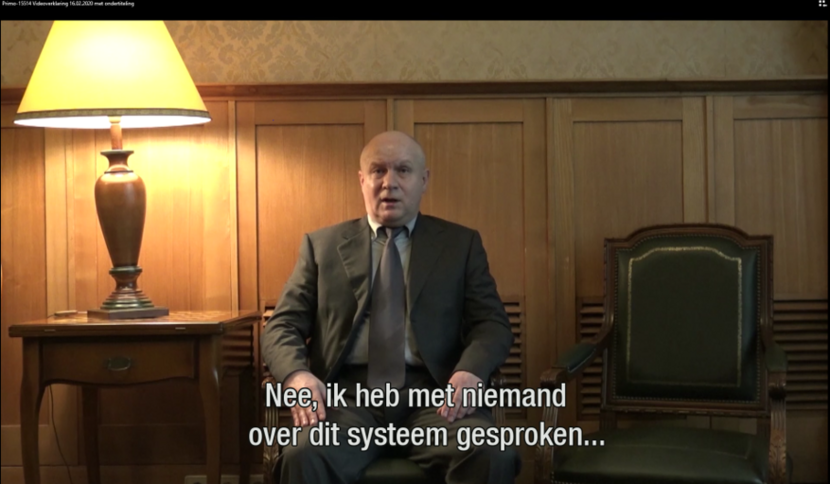
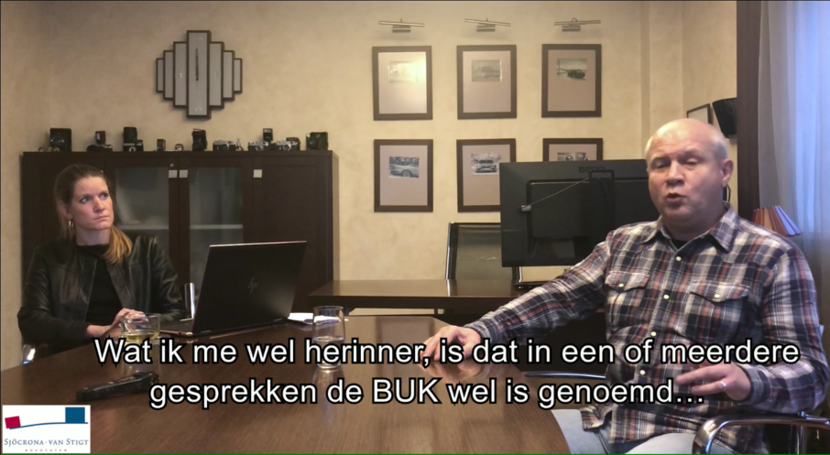
In July 2020 Pulatov stated on the internet forum Glav that while many intercepted conversations, including the one about the Buk, did take place, they were intended to mislead the enemy. This is a striking change of position. As clear as Pulatov is in February 2020 in his denials that he ever spoke about a Buk or heard others speaking about one, he is equally straightforward in October 2020 in confirming that there were telephone conversations about a Buk. He even takes a considerable amount of time to explain why this happened.
3.9.5.3 Pulatov’s explanation of the intercepted conversations
In addition to his statements about the events of July 2014, Pulatov has commented about the reliability of the evidence. As we have said, in October 2020 Pulatov stated that the intercepted conversations could not be considered evidence since they contain inaccurate information. According to him, his ‘open line’ was used to spread disinformation and mislead the enemy. Pulatov contends that the same is true of the conversations about a Buk.
According to him the content of those conversations cannot be taken seriously because they were meant to function as disinformation. This open line was purportedly used to mislead the Ukrainian enemy. In addition Pulatov has stated that the words ‘little box’ and ‘toy’ in certain conversations did not refer to a Buk, but rather to other military equipment. In brief: Pulatov does not dispute his participation in the incriminating intercepted conversations; he simply has a different explanation for them.
3.9.5.3.1 Code words
Regarding the use of code words, we can be brief: we agree with Pulatov that various conversations feature the use of code words, such as ‘little box’ and ‘toy’.
Pulatov says that the code word ‘little box’ ‘could easily be misunderstood’. According to Pulatov a ‘little box’ is materiel. He then adds that such materiel is generally a vehicle, ‘for example a tank, an infantry combat vehicle or a car’. We also conclude that the ‘little box’ mentioned in intercepted conversations refers to materiel in the form of a vehicle. So this is another point of agreement. Only we believe that in these conversations, the vehicle referred to is a TELAR. If Pulatov wishes to take the position that a ‘little box’ can refer to any kind of military materiel except a Buk TELAR, we would point out the fact that multiple separatists refer to a ‘little box’ in one conversation and then use the word ‘Buk’ in other conversations in the same context. For example, Kharchenko is told by Gilazov that a crew member of ‘the Buk’ was left behind, and he then calls Pulatov to ask: ‘Can you contact these fighters from this new box, they have lost their fighter’.
Another code word is ‘toy’. Back in June we highlighted all the other information in the case file relating to the term ‘toy’. This demonstrated that the word does not mean ‘portable materiel’ as Pulatov contends. For example, on 19 July 2014, two days after the downing of MH17, Dubinskiy asks Kharchenko if any of the men who were guarding the ‘toy’ have deserted. Kharchenko, who was himself involved in transporting and guarding the Buk TELAR, says that the people who were guarding ‘the toy’ were his people and that no one has deserted. They are Kharchenko’s men and they are all with him. There is also the conversation of 27 September 2014 involving Dubinskiy, which we spoke about previously. In this conversation Dubinskiy learns that someone is looking for him in connection with the ‘Boeing’. To that Dubinskiy says that it is indeed his voice that can be heard in published conversations on ‘the toy’ that was transported through the DPR area.
In these conversations ‘toy’ does not refer to portable ‘materiel’ as Pulatov claims. It is clear both from these two conversations following the downing of MH17 and from the larger context of various intercepted conversations that occurred on 17 July that the ‘toy’ in question is the Buk TELAR.
3.9.5.3.2 Disinformation
We will now consider Pulatov’s statement that there were unsecured phone lines over which disinformation was deliberately disseminated.
3.9.5.3.2.1 Alleged example of disinformation
He offers only one specific example of such a misleading conversation: that which took place at 18:12 on 16 July, where Pulatov talks to Dubinskiy about a non-operational Strela and the need for air defence systems with a greater range. In the same conversation the men speak about an enemy aircraft flying at high altitude, casualties on the DPR side and the loss of armoured vehicles. According to Pulatov’s later statement of October 2020 the purpose of this conversation was to mislead the enemy. The Strela which is described as non-operational in the conversation was, according to Pulatov, actually in normal working order. In addition, the losses on the DPR side mentioned in the conversation had allegedly been exaggerated and the segment in which they discuss high-altitude enemy aircraft was also not accurate, he claims. In Pulatov’s view, the gist of the conversation was that ‘everything was going fine with them’. We cannot reconcile these assertions. All the subjects touched on in this conversation – the casualties suffered by the DPR, the fact that the Strela-10 was non-operational, the high-altitude air strikes and the loss of armoured vehicles (either to combat or seizure) – are also mentioned in social media posts, interviews and video reports. The claim that 80% of this conversation was fictitious and that the underlying message Pulatov sought to convey was that ‘everything was going fine’ is inconsistent with the circumstances on the ground at that point. The fighting was going just as badly as described by Pulatov and Dubinskiy in this conversation. That is why it was necessary to arrange a Buk.
3.9.5.3.2.2 Broader investigation into the accuracy of the information discussed
Apart from this one conversation of 16 July 2014 Pulatov does not cite any specific examples of misleading conversations. If we look more broadly at other incriminating conversations, the many conversations surrounding them, and the associated historical telephone data, we can see that this information is not misleading at all, but quite accurate. It is not disinformation; it is genuine information about events that had actually occurred. There are many conversations and attempted calls that match up in terms of both their time and their content. They involve a large number of DPR fighters located in many different places who, more or less simultaneously and independently from each other, regularly speak about the same events, events that are also confirmed by other evidence.
This applies, for example, to the large number of casualties suffered by DPR fighters in the fighting on 16 July 2014. Pulatov calls the discussion of losses an example of disinformation he deliberately spread over an ‘open line’ used for that purpose. Yet other conversations involving other DPR fighters and video footage of the fighting on 16 July 2014 also suggest heavy casualties on that day. The fact that intercepted conversations concerned actual events and not disinformation was also established by the broader investigation into the course of the fighting in eastern Ukraine in the summer of 2014 and the role played in the conflict by the Russian Federation. That part of the investigation also involved comparing many hundreds of intercepted conversations with information from other sources. And there, too, investigators were repeatedly able to confirm the accuracy of information from intercepted conversations with the help of other evidence, and thus establish that what was being discussed had actually taken place. This applied, for example, to combat operations, the downing of Ukrainian military aircraft, convoys transporting heavy military equipment, incidents along the Ukrainian-Russian border and artillery fire from Russian territory.
The same happened in the investigation into whether the DPR observed humanitarian law. Here, too, many hundreds of intercepted conversations were analysed in light of other evidence. Investigators were able to establish, for example, that many intercepted conversations in which DPR fighters spoke about people they had captured, extorted, robbed, tortured or killed referred to actual events.
In addition to these broader investigations, a validation investigation was conducted into the conversations about the deployment of the Buk TELAR. A number of random conversations from the same period were also used for control purposes. This investigation focused on establishing whether the content of the conversations was consistent with or diverged from other information. Here, too, the conclusion was that the content of the conversations was reflected in other sources.
Pulatov gives the impression that the DPR was a well-oiled military machine where everyone knew what they could and could not say over which phone lines and only ever revealed information that was intended to be disclosed. The reality was different. In the summer of 2014 people freely shared information over open telephone lines about the identity of DPR fighters in Ukraine and their contacts in the Russian Federation, about the role of the Russian Federation in the armed conflict, about the many criminal offences being systematically committed by the DPR, and about countless military operational matters. This was not done intentionally; after all, the conversations also involved numerous attempts to talk in code and make use of aliases. It was simply unavoidable in the commotion and chaos of the fighting and the internal conflicts within the DPR.
3.9.5.3.2.3 Internal logic of the ‘disinformation’ argument
Finally, Pulatov’s statement about allegedly misleading the enemy is also illogical and inconsistent on its own terms. For example, in his video statement of October 2020, he says, with regard to conversations in which the word ‘Buk’ was used:
‘Well, I can’t... really... call everything to mind, but I do remember that in one or maybe more conversations, a Buk came up in the context of disinformation, given that the day before, I’d already been spreading information to mislead the enemy about a supposedly non-operational Strela-10 installation.’
Speaking about this Strela-10 earlier in the same statement, Pulatov says:
‘As far as the out-of-commission Strela goes, (…) in this case we were using disinformation to show we had no air coverage, to encourage aircraft flying at an altitude of five kilometres to fly lower.’
So according to Pulatov, on one day the enemy would be lured into thinking that the DPR had no air coverage, while a day later that same enemy would be made to believe that the DPR had the best possible air defence: a Buk system. If Pulatov had been hoping that this supposed disinformation would put the Ukrainian armed forces on the wrong track, it is unclear what track he had in mind. Was he trying to attract enemy aircraft, or conversely, ward them off? There is no logic whatsoever in this supposed military strategy.
3.9.5.3.2.4 Sub-conclusion on disinformation
In brief: the intercepted conversations of 16 and 17 July 2014 paint a picture of a chaotic armed conflict, in which the group of defendants were suffering major losses of personnel and equipment and were seeking a solution in the form of the deployment of a Buk system. This picture, which is borne out by many other sources in the case file, bears no resemblance whatsoever to the disinformation campaign that Pulatov suggests he was involved in and which is illogical on its own terms.
3.9.5.4 Sub-Conclusion
We would summarise Pulatov’s position as follows: he denies involvement in the downing of MH17. He has given varying accounts about what he discussed or heard about a Buk during that period and what he observed on the afternoon 17 July 2014. He does not dispute that the intercepted conversations attributed to him took place; rather, he contends that they should be interpreted differently. The explanation he gives for this is incompatible with other evidence and incomprehensible on its own terms.
3.9.6 Conclusion on the defendants’ statements and positions
We will now conclude our discussion of the positions of the four defendants. All four defendants deny involvement in the downing of flight MH17.
However, their remarks contain nothing that causes us to doubt the evidence pointing to their involvement. Indeed, some of what they have said only reinforces the evidence. For example, in a telephone conversation and on an internet forum Dubinskiy stated that he was involved in transporting the Buk TELAR through the territory controlled by the DPR. Girkin has stated that on the afternoon of 17 July 2014 his subordinates reported that they had shot down an aircraft. Pulatov has stated that he recalled a Buk being mentioned in one or more conversations on 17 July 2014.
After extensive investigation, no indications were found that would point to manipulation of the intercepted conversations or the dissemination of disinformation through them. On the contrary, there is abundant evidence that the information shared by the defendants in many conversations was accurate.
Therefore, although one-sided utterances by the defendants may not carry the same weight as an official examination, the defendants’ various statements do not detract from the evidence either.
3.10 Conclusions on the findings of fact
3.10.1 Introduction
As we have just explained, MH17 was shot down by a Buk missile, fired by a Buk TELAR from an agricultural field near Pervomaiskyi. We have also discussed the involvement of the defendants. We now come to the question of whether the defendants, by virtue of this involvement, committed the offences with which they are charged, in other words: whether the actions described in the indictment can be considered proven. In order to do so, it is necessary to focus more closely on the defendants’ actions in relation to the Buk TELAR that downed MH17. After that we will consider the legal qualification of those actions. But first we will take a moment to reflect on the question of what weight was given to the various pieces of evidence.
3.10.2 Weighing up the evidence
During our presentation we mentioned various sources of evidence, such as trace material from the wreckage of MH17 and the victims’ bodies, reports by forensic experts based on that trace material, intercepted telephone conversations and other telecom data associated with the defendants and other individuals, reports by forensic experts on those intercepted conversations, videos and photos of the Buk TELAR, reports by forensic experts on the authenticity of that visual material and witness statements. When viewed collectively and in relation to each other, all these different sources of evidence support and reinforce one another. Therefore, in the opinion of the Public Prosecution Service the evidence for the course of events on 17 July 2014 laid out in the indictment is abundant and convincing.
Some types of evidence have more evidential value than others. In weighing up the various pieces of evidence we make a distinction between objective and subjective sources. For example, more weight is given to factual, objective trace material from the wreckage and the victims’ bodies, telecom data, photos, videos and satellite images than to witness statements. After all, the human memory is fallible and suggestible. We believe that when it comes to assessing the evidence in this case, the court will be able to confine itself to objective sources of evidence and the statements of a limited number of statements by witnesses for which the court decided that they could be further questioned by the defence.
3.10.3 The defendants’ actions
As we have discussed, a considerable amount of evidence shows that MH17 was downed by a Buk missile, which was launched with a Buk TELAR belonging to the 53rd Brigade of the Russian armed forces, and was fired from an agricultural field near Pervomaiskyi in Ukraine, after which the TELAR was transported back to the Russian Federation. If we again set out the individual roles of each defendant in this incident, the following picture emerges.
3.10.3.1 Requesting the Buk TELAR
Starting in May 2014 Girkin, Dubinskiy, Pulatov and Kharchenko play a guiding role within the DPR. In doing so they work closely together. One element of their cooperation relates specifically to the downing of aircraft. To achieve this goal they try to obtain air defence weapons. For example, on 8 June 2014 Girkin expresses his desire for Russian support, among which ‘decent anti-aircraft artillery manned by trained personnel’, to Aksyonov, the Russian-appointed leader of Crimea.
As the conflict continues the defendants’ need for powerful anti-aircraft weapons grows even more pressing. Starting on 6 July 2014 the DPR tries to force a breakthrough to the Russian border in the south of the Donetsk region. Girkin and Dubinskiy plan out the contours of this operation from the city of Donetsk. Pulatov conducts preliminary reconnaissance in the area south of Snizhne in the direction of the border and reports back to Girkin and Dubinskiy. The four defendants play a leading role in this operation. As of 15 July 2014 Kharchenko is in the vanguard of the offensive launched from Snizhne, and on that same day Pulatov is appointed coordinator of all DPR troop movements in the area. In that capacity Pulatov is also in command of an air defence unit commanded by Koreets. Throughout the fighting Girkin and Dubinskiy stay abreast of the situation on the ground. Where necessary, they instruct the DPR units directly, including when heavy-duty military materiel is brought in from Russia on 15 July. The Ukrainian air force tries to prevent the breakthrough to the Russian border, carrying out high-altitude air strikes. As a result, the defendants have a growing need for an even more powerful anti-aircraft weapon with an even greater range than what they already have.
On 16 July 2014 the situation is desperate. There is heavy fighting near the border town Marinovka, with the DPR fighters being attacked from the air. In an intercepted call at 13:26 Kharchenko tells Pulatov about the perilous position in which he finds himself. Kharchenko talks about a Sushka strafing them from above and about the Strela-10 which has apparently been hit. According to Kharchenko there are dead and wounded fighters everywhere. In a later conversation, at 17:11, Kharchenko tells Dubinskiy that they are being fired on and that his unit has sustained many casualties. In a conversation on 16 July 2014 at 18:12 Pulatov reports to Dubinskiy that his men have suffered heavy losses, due in part to an air strike. Pulatov says that they need long-range artillery and good air defence weapons because the combat aircraft was attacking them from a high altitude and thus remained beyond the range of their weapons. Dubinskiy tells Pulatov that he can’t say anything yet about their air defences, but he has marked their artillery targets on the map and Girkin is passing them on to Moscow. Here, too, Girkin again functions as the point of contact with Russia when it comes to military support. And then there is the previously mentioned conversation which takes place at 19:09. In this conversation Dubinskiy says to a fellow fighter that they can withstand the artillery but not the Sushkas if they attack the next morning. Then Dubinskiy says:
‘If I will be able to receive a Buk in the morning and send it there, then it’s OK. If not, things will go totally fucked up.’
So this Buk would meet the defendants’ needs. Less than an hour later the arrangements for the Buk’s arrival are made, as discussed in an intercepted conversation of 20:06. Dubinskiy then calls Pulatov to tell him that if the Buk-M is brought in that night, it will go directly to Pulatov. This is a logical choice, since Pulatov is the troop coordinator in the area and the one who raised the issue of the air strikes with Dubinskiy. ‘That’s clear,’ Pulatov says. Dubinskiy replies: ‘That Buk is our only hope. We’ve got no other choice. Right?’ ‘Right,’ Pulatov replies. That same evening the logistics unit heads out to pick up the requested Buk-TELAR at the eastern border with the Russian Federation. Chernykh maintains in close contact with Dubinskiy on this. In a conversation at 00:17 that night, Dubinskiy tells Khodakovsky, the DPR commander of the Vostok battalion, about the losses after capturing Marinovka. ‘But,’ Dubinskiy says, ‘a Buk is arriving tonight, and then all [our] problems will be solved.’ In short: the suspects need a Buk and arrange one.
3.10.3.2 Deployment of the Buk TELAR
On 17 July 2014 Girkin and Dubinskiy are at the headquarters of the DPR in Donetsk. There, Dubinskiy has a meeting that morning in Girkin’s office with Kharchenko. Intercepted conversations show that the four defendants are in regular contact with one another that day, both in person and by telephone. Many of these conversations deal with the deployment of the Buk. At 09:08 Chernykh tells Dubinskiy that the Buk TELAR has arrived in Donetsk. Dubinskiy then meets with Kharchenko at Girkin’s office. Not long afterwards Dubinskiy informs Pulatov that Kharchenko is on his way to him with the Buk and that the weapon needs to be positioned in the vicinity of Pervomaiskyi. Dubinskiy tells Kharchenko to contact Chernykh and go to Pervomaiskiy to be on standby and guard the Buk. Less than half an hour later, Dubinskiy calls Pulatov and tells him that he and Kharchenko need to go with the Buk to Pervomaiskyi and remain there on standby. Pulatov’s job is to guard the Buk and oversee the general organisation. In that same conversation Pulatov says he already knows what he has to do because he has just spoken to Girkin. This is confirmed by Girkin, who says in another phone conversation that Pulatov is in charge and that he has given him all the necessary instructions. Thus we know that Pulatov was also receiving orders from Girkin.
Kharchenko does as Dubinskiy has instructed. In Donetsk he takes over escorting duties for the Buk convoy from Chernykh. He then instructs his subordinate Sharpov to go to Pervomaiskyi and wait for him there. Shortly before 13:00 Pulatov meets the Buk convoy with Kharchenko at the Furshet supermarket in Snizhne. There, the Buk drives off the trailer and moves through the centre of Snizhne under its own power, in the direction of Pervomaiskyi. Shortly after 14:00 Kharchenko instructs Sharpov to guard the Buk which has come to stop some distance away in the field. Kharchenko picks up Gilazov in Snizhne, and they ride together to the launch site.
While Kharchenko escorts the Buk TELAR to Pervomaiskyi, Pulatov tries to contact the crew. They both do what was discussed that morning and what they were instructed to do by Dubinskiy and Girkin: they see to it that the Buk is positioned in the agricultural field near Pervomaiskyi, and make sure it is secure.
3.10.3.3 Using the Buk TELAR to down an aircraft
A few hours later MH17 is shot down from this location with a Buk missile.
The defendants’ responsibility for the deployment of the Buk TELAR is also in evidence after the downing of MH17. By his own account Girkin is told that afternoon that a Ukrainian air force Su-25 was shot down by the DPR’s air defence near Snizhne. At 16:48 Kharchenko tells Dubinskiy that they are at the location and have already downed one ‘Sushka’. Dubinskiy commends them and tells Kharchenko to come to him. Later Dubinskiy refers to their own (‘our’) Buk and the fact that they themselves (‘we’) shot down an aircraft. Even when it becomes clear that they have shot down a passenger jet, Dubinskiy, Pulatov and Kharchenko continue to speak to one another and to Girkin about the Buk as their own weapon (‘our’, ‘ours’), with which they themselves (‘we’, ‘our people’, ‘our bang’) downed an aircraft. Despite not having pressed the button themselves, in various telephone conversations the defendants thus claim responsibility for the use of the Buk TELAR and the downing of an aircraft with that Buk. Eventually, the defendants conclude in their conversations with one another that the Buk hit an Su-25, after the latter had shot down MH17. It is mainly Pulatov who actively puts forward this alternative reading and suggests it to Dubinskiy and Kharchenko. Dubinskiy then repeats it to Girkin. According to Pulatov the whole world will be talking about this.
3.10.3.4 Removal of the Buk TELAR
As the hours pass, the true nature and full extent of the disaster become clear, and it dawns on the defendants what actually happened. The Buk, which they needed so badly for their military operations, and which was described only a day before as ‘their own hope’, now has to be taken away. The defendants organise the removal of the Buk TELAR to Russia, a process in which they play the same roles as when the weapon was deployed.
At around 20:30 Girkin instructs Dubinskiy to remove the Buk TELAR under escort of two BTRs (armoured vehicles), informing him that a new escort will take over once they reach LPR territory. There, he will be met by a group with a low-loader and a crane. Dubinskiy says that Kharchenko is currently guarding the Buk and has BTRs. Girkin says that he will have to take care of the problem with the aircraft. Immediately after that, Dubinskiy passes on Girkin’s instructions to Kharchenko and tells him that a low-loader will be coming to pick up the Buk TELAR and that the latter will have to be escorted to the LPR border. When Kharchenko calls back 45 minutes later to say that the Buk has already left for Snizhne under its own power, Dubinskiy tells Kharchenko to leave it there and says that he will ask Girkin himself what to do. Evidently it is Girkin who ultimately determines what should be done with the Buk. When one of the Buk’s crew members gets separated from the rest of the crew later that evening, Kharchenko is informed. Kharchenko then calls Pulatov again, to ask if he can contact the crew. Pulatov then attempts to contact the crew, without success. Just as before the downing of MH17, the contact with the crew once again goes through Pulatov. In the end the Buk transport does not depart Snizhne until late in the evening of 17 July 2014, after Dubinskiy gives further instructions to Kharchenko. In accordance with those instructions the next stage of the removal of the Buk is carried out by subordinates of Kharchenko, under his guidance. When the removal does not go according to plan, Girkin intervenes and he keeps after Dubinskiy until he receives word that the Buk TELAR is in Russia.
3.10.3.5 Conclusion
It follows from all this that on 17 July 2014 the four defendants initiated and organised the deployment of the Buk TELAR. From May 2014 onward they have a guiding role within the DPR and in doing so they work together closely, including on the downing of aircraft. On 8 June 2014 a request is made for a more powerful anti-aircraft system with a crew. Over a month later, on 16 July 2014 the situation has become desperate, and once again the need for a decent air defence system is pointed out. The system is delivered that same night. After receiving the Buk TELAR, the defendants escort the weapon to their chosen launch site and ensure that it is guarded. During this time the defendants are in contact with the crew, and after the Buk TELAR shoots down MH17 they ensure that the weapon remains hidden and under guard and that the Buk crew remains together. In their communication after the downing of MH17 the defendants speak to one another about ‘their’ Buk and the question of whether it did its job, and also about ‘their people’ who fired the Buk. The defendants then organise the removal of the weapon. Throughout this whole process the defendants call one another frequently and also have face-to-face discussions in Donetsk and Snizhne. This collaboration begins before the Buk TELAR is delivered and continues until the weapon has returned to the Russian Federation. Girkin and Dubinskiy direct this process remotely. Pulatov and Kharchenko carry out their orders on the ground. They in turn give orders to others and ensure further coordination with regard to the deployment of the Buk TELAR. They thus fulfil the same roles as they have previously when working together in the course of the conflict.
3.10.4 Qualification of the defendants’ actions
The next question is whether the actions of the four defendants constitute the offences with which they are charged: causing an aircraft to crash (offence 1) and murder (offence 2).
The principal charge is that they committed these offences, either as functional perpetrators or functional co-perpetrators. The essence of the concept of functional perpetration is that someone who did not themselves physically commit the criminal act is nonetheless criminally liable because they are responsible for that act. Previously, we provided the court with a written legal framework in which we discussed this form of perpetration at length. Today we will confine ourselves – for the benefit of the wider public – to a few brief observations. Functional perpetration is also sometimes characterised as perpetration by means of others. In simple terms, someone who induces another to commit a criminal offence can also be convicted as the perpetrator of that offence.
For there to be joint perpetration, there must have been sufficient close and deliberate cooperation with one or more other persons, with the emphasis on the cooperation rather than the question of who carried out which specific acts. The defendant’s intellectual or material contribution must be of sufficient weight in that regard. In determining whether the sort of deliberate and close cooperation required for co-perpetration occurred, factors to consider include: the intensity of the cooperation, the division of tasks, the role of the defendants in the preparation, execution or implementation of the offence and the importance of these roles, their presence at key moments and their failure to extricate themselves from the situation at an appropriate moment. The defendant’s own interest in the accomplishment of the offence can also be included in the assessment of joint perpetration. For there to be joint perpetration the defendant thus does not need to have committed a physical act at the scene of the crime. For example, a defendant who played a substantial role in planning and preparing the offence can be designated a co-perpetrator.
Against this backdrop, the following circumstances are relevant for assessing the evidence. Firstly, the four defendants formed a close-knit offender group, which sought to commit violent crimes against aircraft, among other things. Secondly, the previously discussed evidence shows that the four defendants themselves had a clear interest in deploying the Buk TELAR on 17 July 2014: they wanted aircraft to be shot down for the purpose of the military operations they were engaged in at that time. Thirdly, the intercepted telephone conversations reveal a strong sense of ownership among the defendants with regard to the deployment of the Buk TELAR and far-reaching control over that deployment. We will discuss these four circumstances in greater detail.
3.10.4.1 An offender group that worked together closely
First, the defendants constituted a close-knit offender group, which sought to commit violent crimes against Ukrainian aircraft, among other things. In June and July 2014 Girkin, Dubinskiy, Pulatov and Kharchenko, working in close collaboration with one another and other parties, are engaged in an armed conflict against the Ukrainian government. The defendants’ armed group calls itself the Donetsk People’s Republic or DPR. During that period all four defendants have been involved in organising and carrying out acts of violence against Ukrainian military aircraft. Multiple Ukrainian planes and helicopters have been shot down from DPR-controlled territory prior to 17 July 2014. The DPR claims responsibility for these downings on various occasions, both publicly and in intercepted telephone conversations. These intercepted conversation show that all four defendants were actively involved in these activities in the period before 17 July 2014. We therefore conclude that in the period prior to 17 July 2014 the four defendants, working together with each other and with other parties, already formed a close-knit offender group that sought to commit crimes in eastern Ukraine, under which to cause aircraft to crash by force.
This conclusion is relevant to both the evidence of intent for each defendant and the assessment of their individual contributions to the offences with which they are charged. After all, in the case of groups of perpetrators working together closely to execute a common plan, the actions of individual defendants should be expressly assessed in light of the group’s common plan to commit offences.
In carrying out their joint plan to commit violence against Ukrainian aircraft the offender group (composed of the defendants) needed a more powerful air defence weapon which they could use to shoot down aircraft flying at a higher altitude. At the request of the offender group, such a weapon was delivered: the Buk TELAR that shot down MH17. On and around 17 July 2014 the defendants, working together closely in the area controlled by their armed group, subsequently organised the delivery, protection and removal of that Buk TELAR. They called one another frequently and also talked at face-to-face meetings in Donetsk and Snizhne. Kharchenko and Pulatov were the commanders in the field. On the morning of 17 July, Pulatov was ordered by Dubinskiy to guard the Buk together with Kharchenko, and to organise ‘all this’. In the morning Kharchenko joined the Buk TELAR convoy after it arrived in Donetsk and escorted the TELAR to the launch site near Pervomaiskyi. During this period Kharchenko was in charge of transporting and guarding the Buk TELAR. On the way to the launch site Pulatov joined Kharchenko and the Buk convoy. He was the link to the crew. Dubinskiy and Girkin led the operation remotely, and managed every detail of the work performed by their subordinates. The defendants were thus collectively in charge of the deployment of the Buk TELAR. Together, the defendants put ‘their’ Buk TELAR into position, and using that TELAR they implemented their plan of downing an aircraft. This coordination was crucial for the accomplishment of the criminal offence.
Thus, the defendants jointly had the intent to bring down an aircraft. And because an aircraft always has one or persons inside, the defendants also had the joint intent to kill whoever was in the aircraft in question. In addition, given the planned nature of their actions, this intended murder was premeditated.
3.10.4.2 The defendants’ own interest in deploying the Buk TELAR
The defendants themselves had a clear interest in deploying the Buk TELAR. The arrival of the Buk TELAR served the purpose of the four defendants and their armed group: in their conflict with the Ukrainian armed forces, they were suffering high-altitude air strikes, which they could not ward off with the equipment they had at their disposal. The defendants wanted to halt the air strikes by attacking Ukrainian aircraft with the TELAR. As Dubinskiy put it on 16 July 2014: ‘Our only hope is Buk.’ The fact that the deployment of the Buk was in the defendants’ interests is also clear from their subsequent reactions. Dubinskiy, for example, congratulated Kharchenko on downing the aircraft that later turned out to be MH17. Pulatov, too, was pleased that the aircraft had been shot down. In a telephone conversation he says that the person who shot it down is a ‘fucking hero’ who did a ‘swell job’.
3.10.4.3 Ownership of and control over the Buk TELAR
The intercepted conversations between the defendants also reveal a strong sense of ownership on the part of the defendants over the deployment of the Buk TELAR and far-reaching control over that deployment. On the evening of 16 July 2014 Dubinskiy tells Pulatov that if they manage to get hold of a Buk, it will immediately be sent to Pulatov. In another conversation that evening Dubinskiy talks about ‘receiving’ and ‘sending’ a Buk. On the morning of 17 July 2014 Dubinskiy is involved in conversations in which he mentions a ‘Buk-M of mine’ and says that he will explain where it needs to go.
After the downing of the aircraft the defendants’ control over and sense of ownership of the weapon are abundantly clear. It is Girkin who later tells the Russian authorities that in the late afternoon on 17 July 2014 he was informed that the air defence of his armed group had hit an aircraft. After the crash Dubinskiy and Pulatov both refer to ‘our Buk’. Dubinskiy also talks about ‘our boys’ who fired the missile and the fact that ‘we’ have a ‘Buk-M’. Kharchenko speaks about ‘our bang’. These are all clear indications that the four defendants regard the Buk TELAR as ‘their’ weapon and consider the firing of the missile to be ‘their’ achievement.
When the situation takes a different turn, because MH17 turns out to have been shot, the defendants’ ownership and control again come to the fore. When it is not clear what should be done with the Buk TELAR between the launch site and Snizhne, this issue is passed up the chain of command, from Sharpov via Kharchenko and Dubinskiy to Girkin. When a crew member of the Buk TELAR is separated from the rest of the team, Pulatov is enlisted to solve the problem. When the removal of the Buk TELAR does not proceed smoothly, Girkin steps in to deal with the situation personally. From all these conversations it is apparent that it is the four defendants who determine what happens to the Buk TELAR in their territory.
Control over the deployment of the Buk TELAR is not the same as authority over its crew. When we speak of control over the weapon’s deployment we mean: the choice to summon and deploy the Buk TELAR in the defendants’ armed struggle, the choice of where the TELAR should be taken and positioned and the choice to shoot down an incoming aircraft from that location, in the knowledge that the occupants of that aircraft would be killed. In order for functional perpetration to apply, a hierarchical relationship between the perpetrator and the person who actually carries out the acts in question may be relevant, but it not a requirement. The fact that there is no evidence of such a relationship between the four defendants and the crew of the Buk TELAR is therefore no impediment for a finding that the principal charge of functional perpetration has been proven. This sort of hierarchical relationship is principally relevant to the assessment of the passive variant of functional perpetration, whereas these four defendants played an active role.
Obviously there are certain things we cannot establish on the basis of the evidence. After all, the parties in question also made use of secure means of communication which could not be tapped, and there were also in-person meetings. We do not know exactly what instructions Girkin issued on the morning of 17 July 2014; we do not know exactly how the communication proceeded between the TELAR’s crew and the four defendants, and we do not know what prompted the missile to be fired. But that does not make the defendants any less guilty. Anyone who organises, facilitates and actively contributes to a criminal offence and afterwards elatedly discusses the fact that the execution of the offence by ‘his’ people was successful is criminally liable for that offence.
The defence may argue that a conviction can only be handed down if it can be determined in detail for each defendant what their individual contribution was, but this is not the case. When it comes to planned offences that are organised jointly, the emphasis of the evidential question is on the joint, planned organisation and execution, not on the question of what each individual was doing at every moment along the way. And that joint, planned organisation and execution is very clear here, both before and after the launch of the missile. In this connection the close cooperation between the four defendants in the removal of the TELAR constitutes strong additional evidence that they were acting jointly.
3.10.4.4 Conclusion: qualification of the defendants’ conduct
We will now conclude our discussion of this subject. The defendants’ thus had control over the deployment of the weapon and played an active, initiating and organisational role. The defendants used others to serve their own interests and carry out their criminal plan. The fact that they did not push the button themselves is irrelevant from a legal perspective. Under criminal law, if you have another person perform an action, it is just as if you performed that action yourself. These four defendants used the Buk TELAR as their own instrument to shoot down an aircraft. They did this in close and deliberate cooperation. They worked together closely to commit the criminal offence; there was a clear division of tasks between them, and all the defendants played an active and essential role in preparing and executing the offence. The four defendants are therefore jointly responsible for causing flight MH17 to crash and thus for the murders of the 298 people on board. The defendants are guilty of functional co-perpetration of these two offences.
3.11 Conclusion: evidence
In the cases of all four defendants, the Public Prosecution Service requests a finding that the principle charges under offence 1 and offence 2 have been proven, namely that on 17 July 2014, in Ukraine, in Donetsk oblast, they were guilty as functional co-perpetrators of causing MH17 to crash by firing a Buk missile with a Buk TELAR near Pervomaiskyi. There was reason to fear that this action would endanger the lives of the 298 people on board, and they have been killed (principal charge, offence 1). It can also be considered proved that they then and there were guilty as functional co-perpetrators of the murders of those 298 people (principal charge, offence 2).
If it is the court’s opinion that they did not functionally co-perpetrate the offence, then in the view of the Public Prosecution Service they are in any case co-perpetrators of the offence of causing flight MH17 to crash and the murders of those on board, as stated in the alternative charges. As discussed previously, there is abundant evidence that all four of them worked together deliberately and closely to this end and that their individual contribution was of sufficient weight in each instance.
The fact that it was not ultimately a Ukrainian combat aircraft that was shot down, but a civilian aircraft, is no impediment to their conviction. To prove these offences – namely, causing an aircraft to crash and taking the life of another person – it is not necessary that the perpetrator’s intent relate to the status (civil vs. military) of that aircraft or the specific individuals on board. The fact that it turned out to be another aircraft and other people than the defendants had likely intended does not stand in the way of a finding that the charges have been proven. The defendants wanted to shoot down an aircraft, and they succeeded in doing so.
Nor is it an impediment to such a finding that in this case there were more victims than could have fit into a Sushka, which the defendants spoke about afterwards. That risk was an inherent part of the defendants’ joint plan to deploy a heavy-duty, long-range surface-to-air missile, with enormous destructive power against the Ukrainian air force. That same Ukrainian air force also used aircraft that could hold more occupants: the Antonov-26, the Antonov-30 and the Ilyushin-76. Before 17 July 2014 these kinds of reconnaissance and transport aircraft had already been downed by the DPR and LPR, in one case causing the death of 49 people. A military transport aircraft such as the Ilyushin-76 can hold far more people. In these circumstances the defendants’ joint plan entailed a risk that they might hit an aircraft with far more people inside than a Su-25. The fact that the defendants continued to look after the Buk TELAR, even after it had become clear that a passenger jet with a large number of people on board had been hit, is evidence of their continued cooperation. As the Dutch jurist Knigge observed: ‘It is the case more so than in general that anyone who gets other people to do their criminal dirty work for them takes a certain risk (...) Anyone who does not want to take the blame for other people’s mistakes must therefore do the job themselves.’
Together, the four defendants are fully responsible for downing flight MH17, resulting in the deaths of all 298 persons on board, and the murders of those persons.
4 Multiple offences arising from the same act
The crash of flight MH17 and the murders of the 298 people on board were caused by the same act: the firing of the Buk missile. The two offences are part of one and the same complex of criminal acts that occurred at the same time and place. In essence the defendants are facing a single accusation. This is why these two offences can be regarded as arising from a single act and the defendants cannot be punished doubly for the two offences. Under article 55 of the Criminal Code, only one of the provisions in question can be applied, namely that involving the most severe principal penalty. In the present case this actually makes no difference, because both offences carry the same maximum penalty.
The charges to be proven therefore warrant the following legal qualification: the co-perpetration of multiple offences arising from a single act entailing (1) intentionally and unlawfully causing an aircraft to crash, when there is cause to fear that this could endanger the life of another person and the offence leads to a person’s death and (2) multiple counts of murder. Because functional perpetration is not a form of participation, this aspect of the offence was omitted from this qualification.
These are criminal offences, and there are no circumstances that would preclude the criminal nature of these offences or the criminal liability of the four defendants.
5 Claims by the injured parties
It is now time to consider the compensation claims submitted by the next of kin. These claims are being heard in a civil procedure between the next of kin and the four defendants within the criminal proceedings. The Public Prosecution Service is not a party to the civil procedure but will, on the basis of the parties’ positions, advise the court on how to decide.
The Public Prosecution Service is aware that neither a sentence nor compensation can undo or reduce the suffering of the next kin. However, compensation will constitute an acknowledgement that the persons required to pay it – the defendants in this case – are responsible for the suffering that has been caused. Compensation will also meet a need for redress. Some of the next of kin have indicated that this sum may be of assistance in dealing with the financial problems caused by the downing of MH17.
The Legal Aid Team (hereinafter: RBT) and the Public Prosecution Service have already exchanged their provisional positions in writing regarding the injured parties’ claims. Defendant Pulatov’s defence team has chosen not to respond until it presents its statement of the case. The other defendants (Girkin, Dubinskiy and Kharchenko) have not made any comment on this issue so far. This means that we are currently unable to take into account the defendants’ views on the compensation claims.
5.1 The claims
5.1.1 Non-pecuniary damage
According to the RBT's explanatory note, the claims are for compensation for non-pecuniary damage in the sense of mental suffering. In the view of the parties that suffering is determined by:
- being confronted with the sudden death of their loved ones, who were unsuspectingly shot down despite not being involved in any way in the conflict in eastern Ukraine;
- the close relationship with the victims;
- sorrow, stress and other psychological suffering owing to the loss of their loved ones;
- the existence of a persistent complex bereavement disorder, post-traumatic stress disorder, depression and/or other psychological complaints among a large portion of the next of kin;
- enduring full or partial medical incapacity for work among many of the next of kin;
- the rupturing of family relationships caused by the loss of the victims;
- the long period of uncertainty about the fate of loved one(s) and their possessions pending recovery and identification;
- the pain, stress and dehumanising feelings prompted by the way in which their loved ones and possessions were handled prior to recovery (and identification);
- the condition of the victims’ remains;
- being confronted with images and media coverage of the crash;
- the inaccessibility of the crash site;
- enduring uncertainty about the last moments before death;
- enduring uncertainty about the circumstances in which MH17 crashed.
With respect to the amount of non-pecuniary damage for which claims have been submitted, the RBT has chosen to divide the next of kin into three categories based on their relationship to the victim. Fixed amounts of €50,000, €45,000 and €40,000 are being claimed per category.
If a next of kin has lost multiple loved ones, the applicable amounts will be added together.
The Public Prosecution Service notes that the next of kin are claiming compensation for the psychological suffering caused to them. In the Public Prosecution Service's opinion, all these claims are for compensation for non-pecuniary damage that is applicable to all injured parties. This means that compensation is being claimed for suffering experienced in the form of sorrow, bereavement, loss, uncertainty and stress. In the Public Prosecution Service's opinion, it is clear that this suffering applies to all next of kin and that it gives rise to non-pecuniary damage.
5.2 Procedural questions under Dutch law
There are no procedural obstacles to assessing the merits of the claims submitted. We will briefly look at each procedural point in turn.
5.2.1 Competence of the court
The court is competent to take cognisance of the injured parties’ claims.This competence is based on article 51f of the Code of Criminal Procedure and arises from the court's competence in the criminal proceedings against the defendants, irrespective of whether they are conducted as a defended action or in absentia. This competence also arises from the Netherlands’ jurisdiction over these criminal proceedings and all the charges in the indictments in these proceedings.
5.2.2 Admissibility of the injured parties’ claims
With regard to the admissibility of the injured parties, the following applies.
Almost all next of kin who have submitted claims have sufficiently explained that they have the legally required close relationship with the victims affected. For one next of kin the substantiation of this close relationship is insufficient. She is therefore inadmissible in her claim.
For the admissibility of the other next of kin it is important that the connection between the non-pecuniary damage adduced by the injured parties and the downing of flight MH17 is a given. The suffering (in the form of sorrow, bereavement, loss, uncertainty and stress) is more than sufficiently connected to the causing of the crash of flight MH17 and the murder of those on board.
This means that the requirement that the non-pecuniary damage for which claims are submitted can be regarded as direct damage suffered by victims within the meaning of article 51f, paragraph 1 of the Code of Criminal Procedure, as a result of the criminal offences of which we believe the defendants should be convicted, is satisfied.
5.2.3 No disproportionate burden placed on the criminal proceedings (art. 361, paragraph 3 of the Code of Criminal Procedure)
The criminal proceedings against Pulatov are being conducted as a defended action. Given the course of his criminal proceedings, he has had ample opportunities to dispute the injured parties’ claims. He will also be given the opportunity to do so by plea.
With respect to the defendants Girkin, Dubinskiy and Kharchenko, the Public Prosecution Service has made great efforts to inform them about their criminal proceedings, including the right of the next of kin to be heard in court and the possibility for them to submit compensation claims. The court has already ruled that these three defendants are aware of the criminal proceedings being conducted against them. Furthermore, in the course of these criminal proceedings Girkin and Dubinskiy have commented on the hearing of their case.
In view of the foregoing we conclude in accordance with our earlier position that all defendants have been given sufficient opportunity to defend themselves and that they have received a fair trial.
In addition, the consideration of these civil claims has not been to the detriment of the criminal proceedings against the defendants. It is true that a large number of claims have been submitted, but thanks to the uniform substantiation and categorisation of the amounts, the claims are not complex. Furthermore, on account of the round of written observations, the overall consideration of the injured parties’ claims has taken up little of the time reserved for the hearings. All things considered, no disproportionate burden has been placed on these criminal proceedings. The compensation claims of all the injured parties are therefore admissible.
5.3 Assessment of the claims under Ukrainian law
5.3.1 Applicable law
The further (material) assessment of the claims is based on Ukrainian civil law.
5.3.2 Liability
The actions of the defendants which the Public Prosecution Service believes are to be proved will, upon conviction, constitute the following legal elements under Ukrainian civil law: an ‘illegal act’, ‘culpability’ on the part of the defendants and a sufficient ‘causal connection’ with the damage to which the claims relate. Consequently, the defendants are liable for the damage suffered by the next of kin and, in principle, a right to compensation exists.
5.3.3 Damage
The next question is which damage is eligible for compensation under Ukrainian law. Article 23, paragraph 2, at 2 of the Civil Code of Ukraine provides for compensation of ‘moral damages’. This is also described as ‘emotional distress’ or ‘mental suffering and distress’.
The Public Prosecution Service regards these ‘moral damages’ under Ukrainian law as a broad form of non-pecuniary damage which in any case encompasses, without being limited to, the Dutch compensation concept of emotional damage (affectieschade). Under Ukrainian law, the damage claimed by the next of kin is therefore eligible for compensation.
In this connection we would note that, as explained earlier, the Public Prosecution Service understands the claims to relate to compensation for suffering in the form of sorrow, bereavement, loss, uncertainty and stress.
5.3.4 Persons entitled to take legal action
Finally it is necessary to assess whether all of the next of kin who have joined these criminal proceedings as injured parties also have a right to take legal action under Ukrainian law.
Under Ukrainian law, the following persons have a right to take legal action for ‘moral damages’ as a consequence of death: spouses, registered partners, parents, (biological and adopted) children and other persons who cohabited with, shared a joint household with and had mutual rights and obligations with the deceased.
Same-sex partners of victims do not have a right to take legal action under Ukrainian law. We agree with the RBT that they cannot be denied this right. The distinction made under Ukrainian law between same-sex partners and opposite-sex partners is, in the opinion of the Public Prosecution Service, contrary to the Dutch fundamental right to equal treatment and is therefore incompatible with Dutch public policy. Consequently this Ukrainian rule, which differentiates on the basis of sex, must be disapplied. All partners – irrespective of sex – must be deemed persons entitled to take legal action within the meaning of article 1168, paragraph 2 of the Civil Code of Ukraine.
The Public Prosecution Service concludes that all the injured parties have the right to take legal action.
5.3.5 Assessment of non-pecuniary damage
In our view it has therefore been established that the next of kin are eligible for compensation. The hardest and most painful part of assessing the claims is making an assessment of the amount of the damage. The suffering of the next of kin cannot be expressed in monetary terms and any debate about the size of compensation amounts will inevitably detract from the severity of that suffering. Nevertheless, such a discussion cannot be avoided.
As we have already noted, the compensation claims must be assessed under Ukrainian law. That law differs from Dutch law. The different way in which damage is assessed under Ukrainian law means that the outcome may be different from that which would have resulted had the case been assessed under Dutch law. This is inherent in the fact that this is a case involving international aspects. In the opinion of the Public Prosecution Service, this poses no threat to the uniform interpretation and application of the law or to equality under the law. The damage assessment in this case cannot lay down any guidelines for assessing damage in other Dutch criminal proceedings.
Under Ukrainian law, moral damages are assessed on the basis of:
- the nature of the illegal act;
- the seriousness of the physical and mental suffering;
- the scope and duration of the negative consequences of that suffering;
- the scope of the culpability of the person who caused the damage;
- the health situation of the (direct) victim of the illegal act (whereby death is treated as having the highest level of severity) and
- the seriousness of forced changes in day-to-day life and employment relations.
In addition, damage is assessed on the basis of principles of reasonableness, balance and fairness. All the circumstances of the case must be taken into consideration.
The RBT has submitted a number of judgments of Ukrainian courts to give the court an insight into how Ukrainian courts assess non-pecuniary damage and the elements that play a role in their assessment. While those judgments do mention various elements that play a role in assessing non-pecuniary damage, they provide no insight into the weight to be attached to the various factors in the damage assessment. The cases are diverse and there is no common thread to be found in the amount of the damages awarded. The amounts awarded vary greatly. The RBT says that the differences in the assessments made by Ukrainian courts may have a range of causes, such as a lack of comparative cases, differences in the amounts claimed, differences in the courts’ assessment of the damage or the defence mounted against the claims. This may explain why the compensation awards vary but it does not offer a solution for the present case.
If we also take into account that the judgments submitted are not comparable to the MH17 case, the Public Prosecution Service concludes that the Ukrainian case law that has been submitted offers insufficient guidance for assessing the amount of damage suffered by the injured parties in this case. What is therefore required is an individual assessment of all circumstances of this case and the determination of the damage amounts for each category of next of kin, with due observance of the Ukrainian legal principles of reasonableness, balance and fairness. We agree with the RBT that the nationality and the domicile of the next of kin play no role in this respect.
We would reiterate that the Public Prosecution Service regards ‘moral damages’ under Ukrainian law as a broad form of non-pecuniary damage which in any case encompasses, without being limited to, the Dutch concept of emotional damage (affectieschade). Compensation is (per category next of kin) being claimed for the suffering of all injured parties in the form of sorrow, bereavement, loss, uncertainty and stress. These compensation claims are intended to remedy an injustice and to acknowledge and redress what has been done to them and their loved ones. According to the RBT's explanatory note, this redress also played a decisive role in determining and categorising the compensation claims. In the Netherlands, suffering of this nature on the part of next of kin, compensation for which is aimed at acknowledgement and redress, is deemed ‘emotional damage’. Emotional damage is assessed in the Netherlands using fixed (flat-rate) sums. In the Dutch legal system it is assumed – in the knowledge that the suffering cannot be compensated in any way – that these amounts offer (i) recompense for the nature and severity of the damage suffered and the illegal acts of the party who caused it; and (ii) sufficient acknowledgement and redress. As stated earlier, this emotional damage falls within the broader Ukrainian category of ‘moral damages’.
In view of the foregoing and the fact that the criminal proceedings are being conducted in the Netherlands, the Public Prosecution Service believes it is reasonable, when setting the minimum compensation amount, to use as a guideline the fixed-rate sums currently applicable in the Netherlands to emotional damage in cases where death has occurred as a consequence of a serious offence. In the Netherlands the amounts in question range from €17,500 to €20,000. Different amounts are awarded within this range depending on the nature of the next of kin's relationship with the victim, with a higher fixed amount being awarded where the relationship is closer. We would emphasise that the Emotional Damage (Compensation) Decree (Besluit vergoeding affectieschade), in which these sums are laid down, is not the applicable legal basis in this case, since this case is subject to Ukrainian civil law. We have looked at the emotional damage compensation amounts only because we believe that they offer useful guidance in determining what a just compensation award would be in this case. We will begin with the category for which the highest compensation amount is being claimed. Given the nature and seriousness of this case and the consequences for the next of kin, we believe that a basic amount of €20,000 in compensation would be fair and reasonable for the first category of next of kin identified by the RBT. This is the category consisting of spouses, registered partners and life partners (provided that they cohabited with the victim), children (provided that they cohabited with the victim) and parents/guardians (provided that they cohabited with the victim).
We also believe that an additional amount is warranted given the exceptional nature of the damage claimed by the injured parties. Ukrainian law offers scope for such an additional amount because all the circumstances of the case must be taken into account and in these criminal proceedings we are not bound by the upper limit on Dutch emotional damage awards.
We agree with the RBT that this case should be viewed from a Ukrainian perspective. And like the RBT, we have also considered the common characteristic shared by the next of kin that warrants an additional amount of compensation for ‘moral damages’. The RBT has summarised this common characteristic as ‘psychological injury’ which, when coupled with shock damage or ‘another form of harm to the person’, can in the Netherlands lead to the award of a higher amount of compensation than the amount of the emotional damage. As we have said, we must look not to the Dutch framework, but instead to Ukrainian law.
For this case we have based the aforementioned additional amount on the exceptional circumstances adduced in the claim, which are applicable to all next of kin. More specifically, these exceptional circumstances concern the previously mentioned Ukrainian factors used when assessing ‘moral damages’: (ii) the seriousness of the mental suffering and (iii) the scope and duration of the negative consequences of that suffering. We now wish to address these points in more detail.
Various circumstances mentioned by the RBT as determinative of the damage are unique to this case. We are referring here to the extensive and ongoing media coverage of the downing of MH17, which has meant that the next of kin have been continuously confronted with painful reports about the disaster, such as images of the wreckage of MH17 and of armed individuals (the defendants’ fellow fighters) at the crash site. In the past seven years none of the next of kin have been able to avoid these painful, recurring images and reports. This has caused additional suffering. We are also referring to the inaccessibility of the crash site, which meant that the next of kin had no sense of the situation on the ground and could not witness the moment at which their loved ones’ remains were repatriated. This left them with extraordinarily painful uncertainty, postponed their goodbyes and prolonged the point at which they could start to come to terms with their grief.
These factors that warrant an additional amount of compensation are in line with the factors that can be considered under Ukrainian law when assessing ‘moral damages’: observing the wreckage of MH17, observing the crash site and observing the images of the victims’ remains. In addition, there was constant media coverage, which meant that the next of kin were (and still are) repeatedly confronted with the MH17 crash and the deaths of their loved ones.
We now come to the question of what amounts should be linked to the factors that warrant an additional amount of compensation, which apply to all next of kin. Whatever amount is ultimately chosen, it will never properly reflect the suffering endured. However, awarding an amount of some sort will reflect the need for acknowledgement and redress. Taking everything into consideration, we believe that an additional amount of €20,000 for the first category of next of kin would be reasonable, fair and balanced. This means that for this first category a total amount of €40,000 is eligible to be awarded. We would reduce this amount in accordance with the RBT's differentiation by €5,000 per category of next of kin as they become less closely related to their loved ones. For the second category (non-cohabiting children, non-cohabiting parents) we therefore believe that a total amount of €35,000 can be awarded and for the third category (living together as a family: brother/sister, grandparent/grandchildren, aunt/uncle, nephew/niece, in-laws) a total amount of €30,000 can be awarded.
5.3.5.1 Conclusion regarding non-pecuniary damage amounts
In view of the foregoing, the Public Prosecution Service would conclude that the following amounts can be awarded for non-pecuniary damage:
- for category I: spouses and registered partners of the victims and life partners, children, parents and guardians of the victims who cohabited with those victims: an amount of €40,000;
- for category II: non-cohabiting children and parents of victims: an amount of €35,000;
- for category III: brothers, sisters, grandparents, grandchildren, aunts and uncles, nephews and nieces and in-laws who cohabited with victims as part of the same family: an amount of €30,000.
These amounts are applicable to each lost loved one. In the claim that we will later submit to the court, we will include the names of the injured parties per category and per lawyer. If a next of kin has lost multiple loved ones, a multiple of the amount per person should be awarded. This is indicated beside the next of kin's name (e.g. with ‘2x’)
5.3.6 Deductions
The next question is whether there is any reason to deduct earlier payments from third parties to the injured parties from the amounts that are eligible to be awarded.
5.3.6.1 Payments from third parties
Information from the RBT shows that some of the next of kin have received payments from third parties in connection with the MH17 crash. These are:
- a one-off payment from Malaysia Airlines (MAS) to a large number of the next of kin,
- a one-off gift from the Malaysian oil company Petronas for reasons of solidarity, and
- one-off payments under insurance policies taken out by (some of) the victims.
The Public Prosecution Service sees no reason to deduct these payments from the amounts of compensation to be awarded. Ukrainian law does not offer any basis for deducting earlier payments from third parties for the same non-pecuniary damage that is being claimed. It is therefore irrelevant that next of kin have received payments from third parties.
We also see no reason for applying deductions on the basis of Dutch law (article 6:100 of the Dutch Civil Code), given the nature of the insurance policies and the fact that the amounts paid out by MAS, Petronas and insurance companies cannot be deemed non-pecuniary damage. There is therefore nothing to deduct.
5.3.6.2 Subrogation and recourse
We agree with the conclusion of the RBT that under both Ukrainian law and Dutch law the defendants will not face double claims for the non-pecuniary damage from MAS or insurance. Subrogation and recourse therefore do not arise in this case.
5.3.7 Other proceedings
We also wish to consider other compensation proceedings initiated by next of kin against the defendant Girkin in the US courts and against the Russian Federation at the European Court of Human Rights (ECtHR).
5.3.7.1 US civil proceedings against Girkin
The court asked the RBT about the outcome of the US civil proceedings against Girkin, thereby raising the issue of lis pendens. Under article 12 of the Dutch Code of Civil Procedure, a Dutch court can stay civil proceedings if the same case is pending before a court abroad; the Dutch court must subsequently declare that it has no competence if the court abroad has given a judgment that is eligible to be recognised and enforced in the Netherlands.
The RBT indicated that civil judgments have been given in a case brought in the United States by a number of next of kin against the defendant Girkin. According to the RBT, the US court in that case awarded compensation consisting of ‘compensatory damages’ and ‘punitive damages’ and the US award has now become final and unappealable.
We believe that the US proceedings have no bearing on the competence of the court to rule on the compensation claims submitted in the criminal proceedings against Girkin. There are two reasons for this.
First, as we have already stated, the Public Prosecution Service believes that the court's competence to decide on the injured parties’ claims arises from its competence to take cognisance of the criminal proceedings. The aim of the legislature when introducing the procedure to allow injured parties to join the criminal proceedings was to establish a simple, accessible procedure to enable individuals who have suffered damage as the result of a criminal offence to be compensated in so far as possible. Substantive civil law applies in the procedure, but otherwise it is subject to the procedural rules and safeguards of criminal law.That is why the civil law rules on default proceedings in the Dutch Code of Civil Procedure do not apply to these criminal proceedings.The same applies to article 12 of the Code of Civil Procedure; it is not applicable to these criminal proceedings. That is why the earlier judgment in the US civil proceedings ordering Girkin to pay compensation is no obstacle to the court's competence to decide on the compensation claims submitted within his criminal proceedings.
The second reason why the US civil case poses no obstacle to the competence of the court is as follows. Lis pendens concerns a situation in which proceedings are pending between the same parties on the same subject in both the Netherlands and another country. Once final and unappealable judgments have been given by a court abroad, there are no longer proceedings pending abroad and article 12 of the Code of Civil Procedure thus does not apply. Additionally, article 12 is not applicable because the decision of the US court cannot be enforced in the Netherlands.
The only question that the court can and must ask itself is whether it is sure that the consideration of the claims against Girkin is compatible with his right to a fair trial within the meaning of article 6, paragraph 1 of the European Convention on Human Rights. If that question is answered in the negative, the injured parties’ claims must be declared fully or partially inadmissible. It does not detract from the competence of the court in any way.
In this case we do not see the fact that a compensation award has already been made against Girkin in the United States as grounds for declaring the injured parties’ claims inadmissible. This is the case if only because Girkin has not yet paid that compensation and the US decision can be recognised in the Netherlands only once a separate procedure has been pursued. That procedure, however, has not yet commenced. In our view, the next of kin's joining the Dutch criminal proceedings cannot be regarded as such.
In summary: on the basis of article 51f of the Code of Criminal Procedure, the court is competent to decide on these claims against Girkin, and awarding these claims would be compatible with his right to a fair trial.
5.3.7.2 Applications before the European Court of Human Rights
The Public Prosecution Service also agrees with the RBT that the proceedings against the Russian Federation before the ECtHR are irrelevant to the assessment of the compensation claims submitted against the individual defendants in this case.
5.3.8 Joint and several liability
The injured parties have asked for their claims to be awarded on a joint and several basis. This means that the full amount of compensation can be claimed from any of the four defendants, who must then apportion it among themselves. Making the award on this basis is possible under Ukrainian law and the Public Prosecution Service also asks that it be made on this basis.
5.3.9 Statutory interest
Finally, the injured parties have claimed the statutory interest on the compensation awards to be made. Under Ukrainian law, statutory interest can be awarded on a compensation award from the date on which the judgment of the court in question obtains legal force. The Public Prosecution Service considers that in the interest of the proper administration of justice the court should award statutory interest from the date on which the judgment in this case becomes final and unappealable.
5.4 Compensation order
Besides their compensation claims, the injured parties have also asked the court to impose a compensation order on the four defendants on a joint and several basis. When a compensation order is imposed, the Dutch state makes an advance payment of any compensation award, which means that victims and next of kin do not need to collect the amounts themselves from the defendants. Collection will subsequently be carried out by the Dutch government.
5.4.1 Possibility of imposing compensation order
Under article 1, paragraph 2 of the Dutch Criminal Code, the statutory provision on compensation orders (previous version of article 36f of the Criminal Code), as it applied on 17 July 2014, must be deemed applicable. The first paragraph of that article provided for the imposition of a compensation order ‘for the benefit of the victim or their next of kin within the meaning of article 51f, paragraph 2 of the Code of Criminal Procedure’.
The next of kin in this criminal proceeding can be deemed ‘victims’ within the meaning of this previous provision (article 36f, paragraph 1 of the Criminal Code (previous version)). Under article 51a, paragraph 1 of the Code of Criminal Procedure (previous version), as it applied on 17 July 2014, ‘a victim is anyone who has suffered direct damage as a result of a criminal offence consisting of financial loss or any other disadvantage’. This amounts to the same thing as direct damage. As we have already discussed, we believe that the next of kin who have joined the proceedings as injured parties have suffered direct damage. That was already the case on 17 July 2014.
The Public Prosecution Service therefore believes that the compensation order can also be imposed on the defendants for the benefit of the next of kin. It can be imposed at the same time as the sentences, irrespective of the length of any prison sentence.
5.4.2 Amount of compensation order
The compensation order is a criminal law sanction that can be imposed separately from the court's decision in the procedure under which the injured parties have joined the criminal proceedings. The case law of the Supreme Court shows that it possible to set the amount of the payment obligation referred to in article 36f of the Criminal Code at a different amount from the amount of the award made by the court to the injured parties in the same connection. In view of the RBT's explanatory note and the parliamentary history in relation to the compensation order, the Public Prosecution Service sees no reason to set different amounts. We therefore conclude that the amount of the compensation order should be the same as the amounts to be awarded for non-pecuniary damage, plus the statutory interest.
5.4.3 Joint and several imposition
The compensation order should be imposed on a joint and several basis, as requested.
5.4.4 Committal for non-compliance
Finally, we believe that committal should be used to enforce compliance, ensuring that the compensation order is paid. We ask that the number of days’ committal be set at the statutory maximum of one year. We would also note that the application of committal does not eliminate the payment obligation.
5.5 Conclusion: injured parties
In summary, the Public Prosecution Service believes that the court is competent, that the claims of the injured parties – with one exception – are admissible, and that those claims can be awarded up to the following amounts for non-pecuniary damage: €40,000 (category I), €35,000 (category II) and €30,000 (category III) per victim. In addition, a committal order of one year should be imposed for failure to pay the amounts required by the compensation order. The statutory interest may be awarded as of the date on which the judgment becomes final and unappealable. The order against the defendants should be made on a joint and several basis. Any additional or different claim should be denied.
6 Seizure
Now that we have concluded that the offences can be proved and we’ve given our views on the damages claims submitted by the next of kin, it is time to reflect on the items under seizure in this case. The court also must take a decision on this matter.
The Public Prosecution Service can be brief in its remarks on this matter. The items still under seizure are the recovered pieces of wreckage from flight MH17, the various loose missile parts found in Ukraine, the missile parts recovered from various pieces of wreckage and human remains, the surviving pieces of the witness plates, warheads and missile used in the arena tests, the cockpit voice recorder and the flight data recorder. All these items were recorded on the seizure list that we provided to the court.
For administrative purposes the seizure is tied to the case of defendant Girkin. This means that in his case, under the provisions of article 353 of the Code of Criminal Procedure and article 33a of the Criminal Code, we will apply for the following seizure decisions.
The Public Prosecution Service requests that the pieces of wreckage from MH17 be returned to Malaysia airlines. The same applies to the cockpit voice recorder and the flight data recorder.
The loose missile parts recovered from the wreckage, airplanedocuments and human remains should be declared forfeit pursuant to article 33a, paragraph 2a of the Criminal Code. The missile did not formally belong to defendant Girkin – it was a missile of the Russian armed forces, after all – but it can be declared forfeit because the Russian armed forces knew that Girkin and the other defendants would use this missile for the downing of aircraft. We therefore request that all missile parts be declared forfeit.
That brings us lastly to the surviving pieces of the items used in the arena tests. We request that these be returned to those from whom they were seized.
As we have indicated previously, we will execute the court’s decisions on seizure only after the cases against all defendants have been disposed of by final and unappealable judgment. These items will therefore remain available for further investigation as long as the defendants’ cases are still being heard by the courts.
